SOUTH PASADENA HIGH SCHOOL 1401 FREMONT AVE, SOUTH PASADENA, CA 91030
PCC OUTREACH PINK OUT ARTS CRAWL
Pasadena City College will be hosting an outreach visit at the little theatre on Wednesday, Oct. 26.
SPHS ASB will put on a Pink Out Spirit Day for breast cancer awareness on Friday, Oct. 21.
South Pasadena will host the Arts Crawl on Saturday, Oct. 29 from 3-8 p.m. for a night of art and music
SPHS teacher recognized with award
STORY ETHAN KWAK PHOTO EMIKO (EMI) ESSMILLER
English teacher Rama Kadri was awarded as a recipient of the 2022 University of Chicago Outstanding Educator Award. Kadri also received a certificate and commemorative award for her nomination. According to the University of Chicago website, the award “gives newly admitted students the opportunity to recognize the educators who have made a difference in their lives.” Only a small handful of educators are chosen from the thousands of schools globally attended by UChicago students. Teacher nominees share many characteristics such as passion and kindness and go above and beyond teaching requirements.
When debating between a career in law or education, Kadri took into consideration her love of reading, leadership, and literary analysis. Ultimately, she decided on education. Now, six years into teaching at SPHS and eight years into her career in education, Kadri’s passion and dedication shows in her professional and personal interactions.
“I wanted to become a teacher so that I could work with students and hopefully spark their passion for making meaningful change in the world around them,” Kadri said.
When she initially received notice of her awardment, Kadri felt extremely humbled. She never expected to be recognized for her work as an educator.
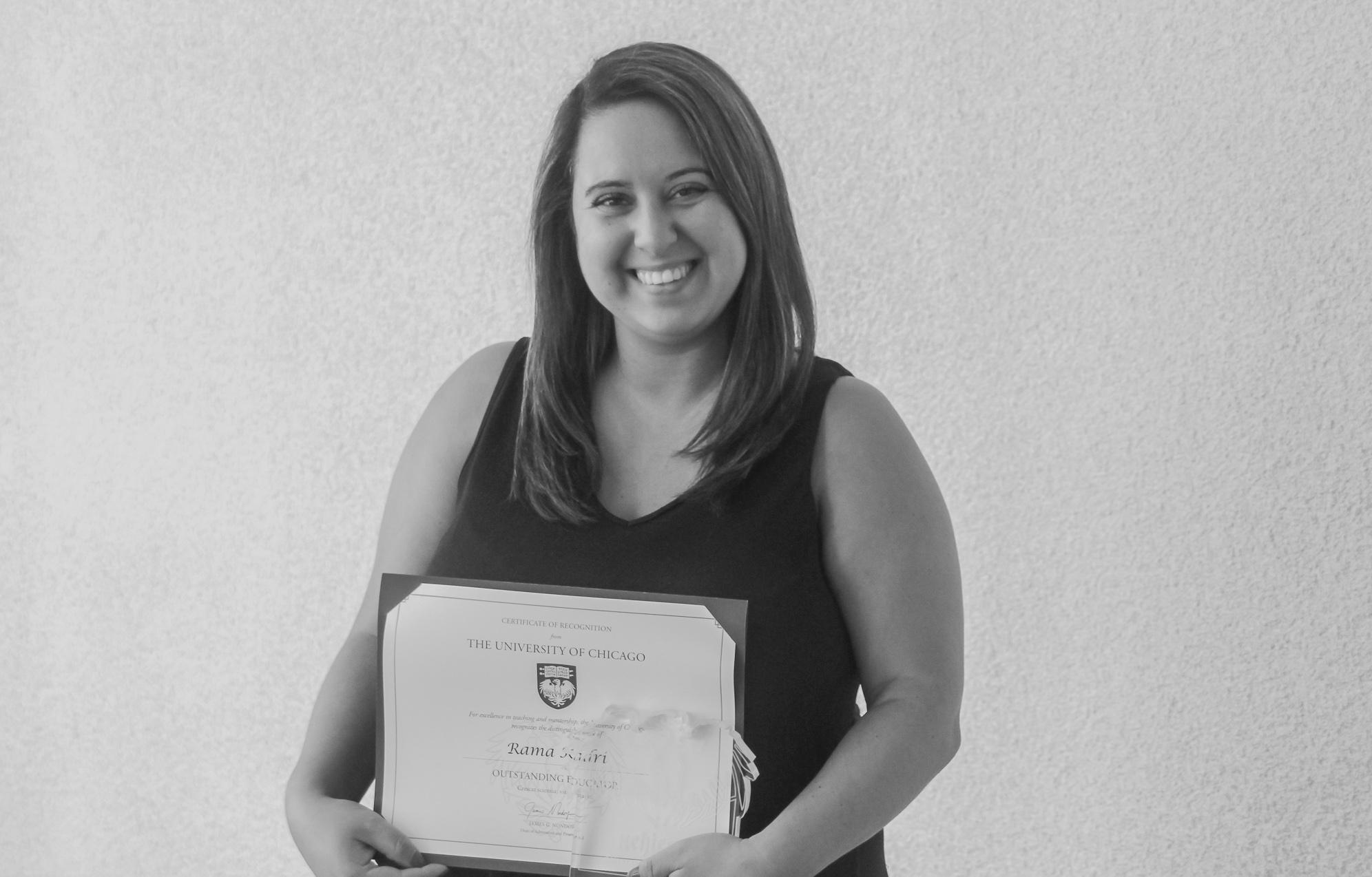
“It means a lot especially because I had gotten to know [the student who nominated me for the award] at a personal level for all four years of high school through Peer Mediators,” Kadri said. “This really reinforces how much I value building personal connections with students. These relationships are one of the main reasons I do this job.”
THE TAO OF SEX Tiger analyzes how religious institutions have stigmatized sex and expresses how the American sexual liberation movement has mimicked established Eastern philosophies.

As an English teacher, Kadri’s passion for social issues often brings her instruction beyond just textbook learning.
A strong advocate for progressive education, Kadri strives to make her classroom a safe and inclusive space for all, evidenced by the motivational and social justice posters adorning the walls.
“I definitely think I’m someone who really advocates for a progressive mindset,” Kadri said. “My passion for social issues is something that drives my instruction and my interactions with students.”
Kadri serves as the advisor of the Peer Mediators and the Anti-Bias Club. As an advisor, she facilitates what these student-led directives focus on. The Peer Mediators work on resolving student conflicts and raising awareness about student health issues around campus.
On the other hand, the Anti-Bias Club engages in discussions on how to approach racism effectively at SPHS and the South Pasadena Community, and the group also educates students at the South Pas elementary schools and have been advocating for a Black Lives Matter Mural in the city.
Additionally, Kadri finds it important to highlight the collaboration of teachers and staff to ensure an all-encompassing education for SPHS students.
“I think it’s important to celebrate the efforts of SPHS’s entire school staff,” Kadri said. They are dedicated to not only supporting students academically and professionally but also personally in what they are passionate about.”
HORROR VILLAINS

Tiger explores how societal ills that are present within American culture are represented as the antagonists of stories within horror films and pop culture.
Hoping for another successful year, the South Pasadena Girls’ Basketball Team prepares for their Rio Hondo League games starting their season in the first week of January.

Page 7
GIRLS BASKETBALL
Page 12 Page 14
VOLUME 109 ISSUE 2 OCTOBER 20. 2022
IN THE NEWS
Empowering students to think critically and creatively since 1913
TIGERNEWSPAPER.COM
South Pasadena adopts mobile app
STORY JAYDEN TRAN ILLUSTRATION ELLIE NAKAMURA
The city of South Pasadena developed and announced a new mobile app, SouthPas Mobile, to the community that went live on September 8, 2022. The system has been a topic of passion and interest for the city council with the app being spoken on throughout recent council hearings.

Mayor Pro Tempore Jon Primuth has emphasized the significance of the app to promote the new Strategic Plan goal proposed by the city to promote and further customer service for citizens.
The app was launched after discussion regarding the budget for technology and communication and the need for the improvement of these systems in the city.
The release of SouthPas Mobile was followed by city council discussions on September 21, 2022 and October 5, 2022 and demonstrations on the days following.
The app, which is available for download on the App Store and the Google Play Store, serves as an informational hub for the city and its affairs.
South Pasadena’s city staff worked during a monthly Tech Day to offer support for the elderly population of the community at the senior center. The city is promoting the app’s various features to serve the general public.
SouthPas Mobile has been in development since late June, spearheaded by the City Manager’s office who worked closely in tandem with Department Directors and staff of the city of South Pasadena.
The main purpose of the app is to serve as a liaison for all information pertaining to the city.
The platform includes details such as frequently asked questions, contact information for officials, and any citybased inquires or notifications.
The app will also provide further guidance on future plans for the city, including elections, park programs, news, jobs, and South Pasadena related events.
Another significant aspect of the software involves a system of reporting for South Pasadena residents. Citizens of the city can create an account to file a report in regards to issues such as “Building Permits”, “Fire Prevention”, and “Park Maintenance.”
These reports will be read and filed by the city before being investigated through service requests.
The city acknowledges the possibility of some citizens not having a smartphone to access the platform on, and have included the report system on the official city website as well.
With the release of the new app, the city officials of South Pasadena seek to improve communication within the city and promote accessibility of city information.
SPHS alumni open basketball club for local players
STORY CLEMENTINE EVANS PHOTO SHIN-HYE (RACHEL) CHOI
Danny Rios, alumnus of South Pasadena High School, used his time during the pandemic in Aug. of 2021 by starting a basketball club for kids, Precision Basketball. The club offers proper basketball training to the youth around and in the 91030 community. Rios wanted to give kids the opportunity to play basketball in a safe area where they could also have fun and to step up their game in basketball.

“Initially, it was more so to provide kids in the area with [proper basketball training],” Rios said, “And then once we started forming the club, we kicked it to the next level where we can build a community while still offering training.”
His goal was to create a foundation with a deeply connected community, Danny Rios and his brother Manny Rios, started from the ground up, both graduating from SPHS.
Currently in South Pasadena and Alhambra, Precision extends to the people around them by connecting the community through basketball.
They have Parent’s Day, where parents of players can get to know each other at the club and play a game while being coached by their kids. They also had Media Day, where the club took photos and videos of the players at the club.
“The interaction and involvement in the community [is amazing].” D. Rios said, “We host a lot of community events and we get a pretty good turnout, so different parents with other parents in the club.”
Their club has given opportunities for the youth around them by giving kids the chance to play organized basketball.
The club is also a non-profit organization which allows them to provide financial aid to families who may not be able to afford their club.
“We don’t really turn away kids who can[not] afford it.” D. Rios said, “We put them on certain plans to help [them] out.”
The Rios brothers wanted to create a club that was not just about playing, but also about having a family and supportive community within the program.
“The good thing about having basketball in this area, in South Pasadena, [it] is very tight, so it feels like a big world and it keeps expanding, but at the end of the day, you end up meeting people that you already [know].” M. Rios said. Precision promotes a connected environment where everyone is part of the same family.
“With basketball, and life in general, just keep having fun, no one is going to tell you what to do, so it is up to you.” M. Rios said, “Hopefully, you choose the fun route.”
His encouraging words have helped him sustain the positive coaching atmosphere at the club.
Handling the housing crisis
THE SOUTH PASADENA CITY COUNCIL unveiled a new mobile app for citizens to utilize for affairs related to the city following discussions regarding the city’s communications and technology budget.
The city of South Pasadena recently moved forward with house inspections of Caltrans homes in a city council meeting on Wednesday, Oct. 5. This would precede the purchase or sale of the homes that were abandoned from the canceled extension of the 710 freeway.
The introduction of the 710 freeway into South Pasadena and nearby cities has been contestedfought since its original proposal by both the cities and residents.
In preparation for the construction, the California Department of Transportation used eminent domain in order to evict residents of homes in the way of the extension. However, due to the city’s overwhelming pressure against the project, it was finally canceled in 2017.
Of the 68 properties in South Pasadena alone, 46 were rented out, while the other 20 were left abandoned. The remaining 2 properties are undeveloped lots. In a few of the abandoned homes, nearby residents filed multiple reports of squatters living on the property.
“Instead of having homeowners who care about the upkeep of their properties, the homes have been left abandoned for years,” nearby resident Brandon Fox said. “The abandoned homes say a lot about the dysfunction within our government. We are told about a housing crisis and how we need to build more homes to solve it, but there are many vacant homes in Pasadena and South Pasadena that have not been lived in for years.”
DESIGN ELLIE NAKAMURA
Other residents shared similar concerns about the process within the city’s government and the lack of communication with residents.
“It’s frustrating how long the situation has remained unchanged. Our primary concern is that the homes ultimately wind up in the hands of owners who have a commitment to an investment in the long-term future of South Pasadena,.” said resident Lennette Lee. “As it stands, we have not been asked for this input, and it does not seem like the law takes the residents’ concerns into consideration.”
After years of debate in the city’s government, the city council moved forward last year in negotiations with Caltrans who proposed bill SB- 381 that would allow the city to buy or sell many of the properties, in part to the current renters of 46 of the homes.

The bill also provided for organizations to buy some of the houses to develop into affordable housing or HRE’s which could be used for purposes such as transitional homes, halfway homes, and group homes.
However, some residents took sides, for or against the HRE’s and the bill, in comments to city council.
“I feel very strongly, however, that the unoccupied properties should be transformed into affordable housing. There is no such thing in our neighborhood now, which is precisely the reason to provide it, contrary to the arguments of some of my neighbors,.” resident John Healy wrote in a public comment during a city council meeting during a city council meeting on Sep. 21.
STORY ROSE VANDEVELDE
PHOTO SAMANTHA SHIROISHI
TIGER OCTOBER 20, 2022
THE CITY CONTINUES THEIR PLANS in transferring possession of Caltrans homes despite contentions over new ownership.
PAGE
NEWS 2
Virtual Enterprise hosts major conference
Virtual Enterprise students across Southern California gather at SPHS to learn about the professional business field and network with other students.
STORY ISU PARK PHOTOS SAMANTHA SHIROISHI

On Thursday, Oct. 13, SPHS Virtual Business held the annual Virtual Enterprise Student Leadership Training. The conference connected several different Southern California high schools that participate in the Virtual Enterprise International program, with an estimate of about 420 students present at the event.
Students were able to experience the business world by attending workshops, meeting with professionals, and networking with fellow Virtual Business members. Among the workshops, students learned about marketing, global business, customer empathy, and graphic design to name a few.
Many speakers who work in the entrepreneurship industry took the time to attend the conference including Pat McNally on international business building, Dr. Alex Liu on the future of technology in business, and SPHS teacher, Sandra Matson-Fennel on graphic design.
SPHS Virtual Business has hosted many leadership conferences on the SPHS campus in the past, with the exception of 2021 and 2020 due to COVID-19.
“Last year we just had different workshop speakers come speak to our Virtual Business class and it was recorded for other schools to then watch on their own time,” Chief Operating Officer, senior Annete Woo said.
The leadership conferences are finally able to be held in person for the first time in three years. Junior Sydney Lee, the Virtual Business club president, assisted with the organizing of the event.
I think it’s a great opportunity for virtual business students from all levels to hear from experienced speakers with diverse backgrounds and learn applicable knowledge on how to grow as a leader,” Lee said. “This allowed all students to find something they could personally connect with and grow from.”


Odyssey Chief Executive Officer, senior Avik Gautam, assisted Lee in planning the event.
“As compared to last year, the conference was a huge step-up with a large turnout for our various workshops,” Gautam said. “For the first time in three years, being able to meet other students in the LA region who each shared the same passion for business made this event memorable for everyone involved.”
Members of the SPHS Varsity Virtual Business team, South Pasadena’s nationally competing business team, claimed that this year’s leadership conference was a rewarding experience.
“I gained an interactive experience and met people that were all passionate about what we’re all doing,” Odyssey, Sales Specialist, senior Ellie Renfrew said. “It really established how big of a community that Virtual Business is and how important it is to the students and staff.”
High schools throughout the Los Angeles region participated in the event. Erika Salcedo, a student at Murrieta Valley High School and CEO of her Virtual Business company, claimed that the communication workshops of the conference were her greatest takeaways from attending.
KEYNOTE SPEAKERS LIKE RYAN CHASE offered conference attendees insight on business strategies.
Almost all of the workshops were centered around communication,” Salcedo said. “Speakers welcomed students’ opinions, allowing for us to provide input and practice public speaking. Beyond that, most students were so open to talking with students from other [Virtual Enterprise]schools and companies. It was definitely a very fun experience and I’m so glad I was able to be a part of the experience.”
Gautam anticipates a successful remainder of the year for Virtual Business.
South Pasadena has always established a standard of success in Virtual Enterprise, and this year we plan to maintain that,” Gautam said. “With a strong team, holding the experience and technical ability paired along with the creativity shown in all aspects of the company, Odyssey has a bright future ahead and looks to exceed expectations in all of our competitions.”
Tiger’s top photos for SPHS’s 2022 Homecoming

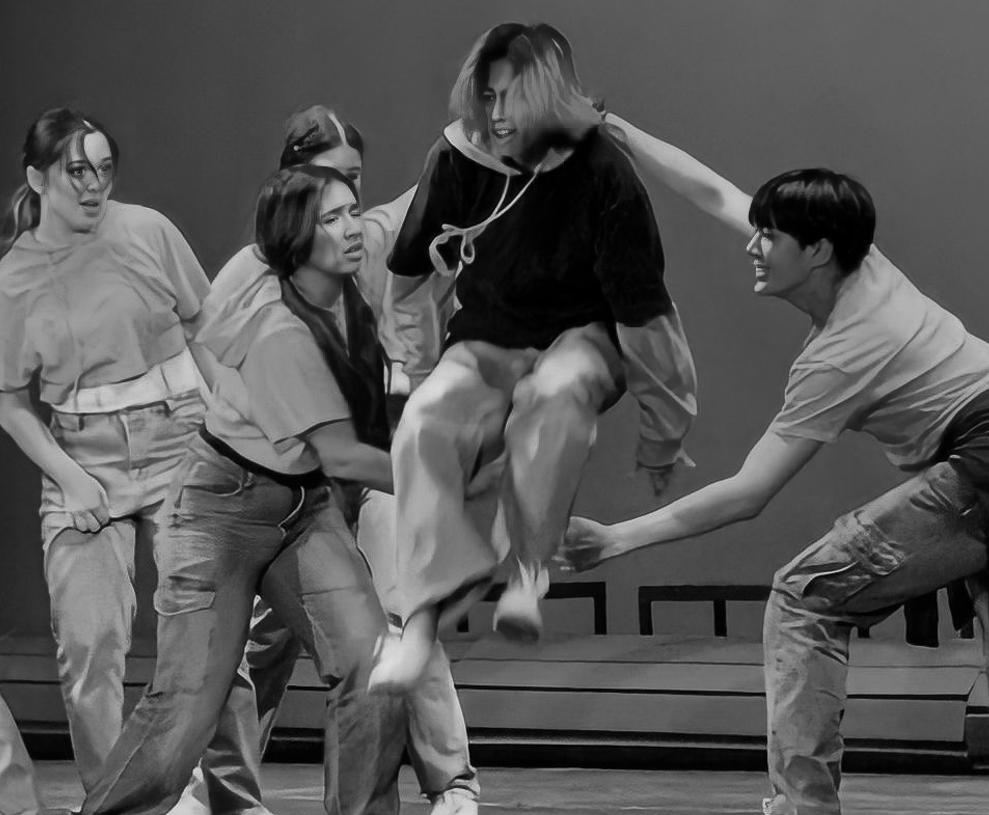




TIGER OCTOBER 20, 2022
PAGE DESIGN ALLISON LEE
PHOTOS EMIKO (EMI) ESSMILLER, SHIN-HYE (RACHEL) CHOI, & SAMANTHA SHIROISHI
LAYOUT ALLISON LEE, MICHELLE SHADMON, & JAYDEN TRAN
3NEWS
Filipino Heritage Month
KAHLEN MIAO, ISU PARK, & ELSIE WATERS
PAGE DESIGN ALLISON LEEILLUSTRATIONS ALLISON LEE
Club celebrates Filipino culture
The SPHS Filipino Cultural Club is one of this year’s new additions to identity-based clubs on campus that meets every Wednesday during lunch. The group made their debut at the Homecoming Picnic on Friday, Oct. 6 where they fundraised with traditional Filipino foods such as Turon and Lumpia. As an affinity group with an activist-motivation, the club strives to create a supportive and understanding environment for Filipino students as well as promote an accurate education on Filipino culture and history.
“It’s important for the Filipino Cultural Club to exist so we can create a safe space where all backgrounds can come together to strengthen the involvement of the Filipino American community on campus,” President Bobbi Kelly said.
Throughout the year, the club plans on spreading accurate information on Filipino American heritage, as well as collaborating with LA based social advocacy coalitions for special events.

“The [club] is hoping to raise awareness about Filipino culture to students not just
of Filipino descent, but all races. Especially through participation events that we want to hold throughout the school year; from internship opportunities to cultural education workshops to youth programs”, Kelly said.
Many of SPHS’ Filipino students have since joined the alliance in hopes of learning Filipino heritage and making a contribution to the club’s overall goals. Senior Danerys (Dani) Pangelinan, was eager to join the Filipino Cultural
Filipinos in America
Filipino American History Month is celebrated annually in October to commemorate the first recorded presence of Filipinos in continental United States which took place on Oct. 18, 1587 after the “Luzones Indios” came ashore from a Spanish galleon to arrive in what is now Morro Bay California.
Filipino Americans established their first recorded North American settlement in St. Malo, Louisiana and other settlements followed shortly thereafter throughout the Louisiana bayous with the Manila Village in Barataria Bay being the largest. From 1763 to 1906 other Filipino groups such as mariners, adventurers and domestics expanded. Some later migrated to the West Coast, Hawaii, and Alaska to explore fishing and whaling industries.
Filipinos have played many roles in American history. Both male and female Filipino Americans made contributions fighting alongside other Americans during World War II. Filipino Men fought in the USAFFE, the Philippine Army, or other various guerilla factions, instrumental in their liberation of allied prisoners. While women often served as medical aides and nurses, messengers, spies, and even joined guerilla battalions.
Filipino Americans additionally made significant contributions to the American Labor Movement, fighting for better wages and working conditions through organized protests such as the Delano Grape Strike. In collaboration with Latin Americans, the two groups organized a successful strike against agribusiness.

It was not until 2009 that the U.S. Congress formally recognized October as Filipino American History month. This act was in large part due to the founder and president of the Filipino American National History Society, Dr. Laigo Cordova and her late husband, Dr. Fred Cordova. The Cordovas founded Filipino American National History Society (FANHS) in the state of Washington as a non-profit organization in 1985. FANHS has continued to grow as a volunteer-run organization, governed by 27-members of the FANHS Board of Trustees, with the FANHS National Office and National Pinoy Archives in Seattle, Washington; a FANHS National Museum in Stockton, California; and over 40 Chapters throughout the U.S.
The organization promotes the enrichment, appreciation, and understanding through the preservation and dissemination of history and culture of Filipino Americans in the U.S. Following the Congressional acknowledgement of Filipino American History month, various states, counties, and cities in the U.S. have established proclamations and resolutions declaring observance of Filipino American History Month. This year’s theme is, “Celebrating our History and Legacies: 50 Years of Filipino American Studies, 40 Years of FANHS, and 30 years of Filipino American History Month.”
Club as secretary because of the little attention that South Pasadena has given Filipino culture in past years.
“It was kind of ridiculous there wasn’t a Filipino Club already, but personally, I don’t really know a lot of Filipino people especially in South Pasadena. As for Filipino culture, it’s difficult to say what that means to me because Filipinos are known for assimilating,” Pngelian said. “My family will always lean towards Western ideals and standards like in beauty. Also, the access that we have about our history and our culture is really limited, so the only sources you get are actual people. That’s why it’s important we have a community.”
The club held its first meeting on Wednesday, Oct. 19. In light of Filipino American History Month, the club is planning to center their work on parts of Los Angeles County with concentrated Filipino communities.
“We are working with SIPA, or Search To Involve Pilipino Americans. It’s a non-profit organization in LA and essentially what they do is help enhance and enrich the lives in LA’s historic Filipino town,” Kelly stated, “We are going to organize a donation drive, like a big balikbayan box, to help them empower future Filipino generations.”
Filipinos in activism
As Filipino immigration to the United States increased in the early 1900s, they became citizens when they were sourced out as cheap labor in industries such as agriculture and domestic servitude. Loose and oppressive labor laws that kept wages low and work conditions unsafe, as well as changing immigration policies and many other issues, prompted the Manong generation (the first generation of Filipino Americans to immigrate to America) to fight back.
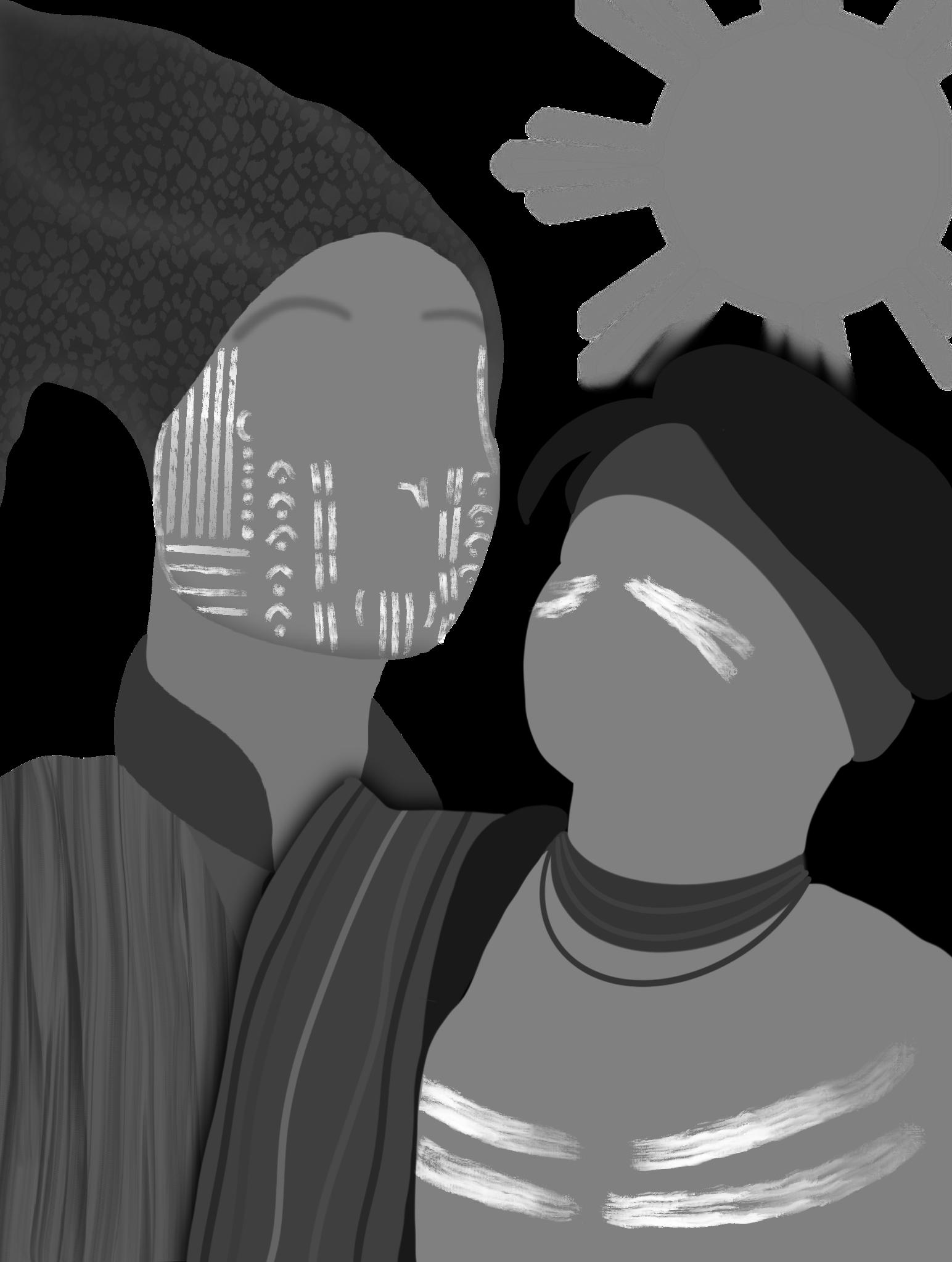
In a series of worker demonstrations and strikes, members of the community worked to argue higher wages and safer working conditions. Many of the demonstrations were led by labor organizer Larry Itliong, leader of AFL–CIO union Agricultural Workers Organizing Committee where, at the time, was a majority of Filipino Americans who immigrated in the 1930s. Itliong would also later work alongside Cesar Chavez in multiple labor and union organizations and is largely recognized as a key figure of the Asian American Movement.
Filipino Americans have been involved in other movements both in the United States and the Philippines including the fight for more labor rights, ethnic studies, other well known social and political movements as well as the Anti-Martial Law movement, which has spanned many decades.
TIGER OCTOBER 20, 2022
In 2020, the Filipino American National Historical Society (FANHS) centered the year’s Filipino National History Month theme around the concept of Filipino American activism and highlighted their involvement in social justice movements throughout history.
4 NEWS
THE TIGER
ESTABLISHED 1913
CSPA SILVER CROWN 2021
CSPA GOLD MEDALIST 2019
CSPA SILVER CROWN 2018
CSPA GOLD MEDALIST 2017
CSPA CROWN AWARD 2016
CSPA GOLD MEDALIST 2015
CSPA GOLD MEDALIST 2014
CSPA GOLD MEDALIST 2013
CSPA GOLD MEDALIST 2011
EDITOR-IN-CHIEF ANIKA EBBERT
MANAGING EDITORS
HANNA BAE, Print
ELSIE WATERS, Online
NEWS
KAHLEN MIAO, Editor
OPINION HANNA BAE, Editor
FEATURE
ELSIE WATERS, Editor
SPORTS
BENJAMIN REGAN, Editor
DESIGN ALLISON LEE, Editor
PHOTOGRAPHY
MICHELLE SHADMON, Editor
COPY
KAHLEN MIAO, Editor
RALUCA TUDUSCIUC, Editor
STAFF WRITERS
ADA BORREDON CLEMETINE EVANS
ETHAN KWAK ISU PARK MORGAN SUN JAYDEN TRAN ROSE VANDEVELDE LINDA YUN
PHOTOGRAPHERS
SHIN-HYE (RACHEL) CHOI EMIKO (EMI) ESSMILLER
SAMANTHA SHIROISHI
ILLUSTRATORS
ISOLE KIM ETHAN LYONS ELLA MIZOTA-WANG
GRAPHIC DESIGNER
ELLIE NAKAMURA
BUSINESS AND ADS MANAGER REV BRICK
ADVISOR
HAMES
STAFF EDITORIAL
OPINION
Elderly people are not babies

The infantilization of old people causes changes in perspectives of aging.
The attention that can be generated by the elderly community while online is prevalent while scrolling on social media.
Celebrating small achievements like grabbing Keurig pots off of the top shelf to the notions of nursing homes, recent years have shown a shift in interactions with the elderly. Rather than treating these individuals as if they have experienced more time on the planet, older people have become more and more infantilized; they are seen as on par to children in function and capability by the media and by younger generations.
Everything from cooing elderly people to slowing down speech is a result of the infantilization of older generations. The rising population of elderly individuals being infantilized is shaping a new form of discrimination known as ageism, which involves the stereotypes and ideology against growing old. The rising involvement of this culture is indirectly hurting those who are aging and creating a culture against maturing.
This very idea is inherently harmful to the concept of maturing, and is becoming significantly frequent in institutions such as nursing homes, hospitals, grocery stores, and more.
Infantilizing the elderly has altered the very connections and interactions that they have in their everyday lives. Forced to listening to over-enunciated words in simplified speech patterns with an emphasis on the volume and a lack of individual pronoun usage, elderly people face a multitude of altercations to typical conversations. Scientists have deemed this term as elderspeak, which is now being compared to how pet owners raise their pitch when speaking to their pets or how parents coo their babies when teaching them.
“Those little insults can lead to more negative images of aging,” a professor of social and behavioral sciences at Yale University Doctor Becca Levy, said. Levy conducted several studies on the impacts of elderspeak and the overall concept of infantilized elderly people.
The American culture of ageism and infantilizing the elderly is becoming systemic, so much so that it has taken root in institutions. The very concept of nursing homes, while helpful for elderly individuals who face problems such as dementia, have created controversy in regards to ageism.
In a 2022 study, the World Health Organization reported that two-thirds of nursing facility staff have claimed to commit abuse in the past year. Cases of abuse in nursing homes have maintained consistent for the past few years, with individuals sharing stories of abuse inflicted upon their family that they have witnessed occur while in the care of staff.
Working with and understanding elderly individuals diagnosed with chronic diseases such as dementia and alzheimers is more convoluted than the training that nursery homes provide. Instead of learning from and engaging in aid, nursing home workers handle terror and breakdowns with abuse and violence, which only furthers the problems that elderly individuals face and in regards to ageism as these attacks continue to go viral online but fail to be addressed.
The infantilization of the elderly community reveals the rampant discrimination within American culture. Ageism grows in the nation through the violence taking place in nursing homes and the elderspeak that dehumanizes the old, creating a stigma against the views of growing up.
By treating elderly individuals as though they are infants, condescending, dehumanizing, and demeaning behavior begins to arise in all forms of interaction involving the elderly.
This culture will continue to grow through virality and abuse, furthering the stigma against aging that plagues American culture. Elderly people deserve to have their independence and live their lives without being the topic of a random recording being uploaded to TikTok of them shopping for groceries or feeding their cat.
Boos & Bravos
Tiger’s cheers and jeers for the month of October
BOO to the dance circle at Homecoming. This isn’t a Bar Mitzvah — Hava Na-Get out of there.
BOO to straws. I am surely on my last one.
BOO to Rex Orange County. Sex offender, is that what I’m supposed to be?
BOO to skater boys. I will see you later boy.
BOO to Instagram plugs. Would not be surprised if my mom was following you at this point.
BOO to robbery. No, YOU empty YOUR pockets!
BRAVO to television for distracting the kids I babysit. Go, dancing watermelon, go!
BRAVO to Lea Michele in Funny Girl. Don’t tell her not to live, just sit and putter (She can’t read this).
BRAVO to gaslighting. You all are crazy.
BRAVO to Ned Fulmer. New video idea: The Try Guys try adultery.
BRAVO to morally ambiguous characters in literature. Yes, I too, am a problematic middle-aged man acting from the goodness of my heart <3.
TIGER OCTOBER 20, 2022
BRAVOSBOOS
PAGE DESIGN ISOLE KIM 5
FACULTY
KAREN
VOL. 109 NO. 2 DISTRIBUTED ON OCTOBER 20, 2022. DISTRIBUTION: 1477 STUDENTS; 70 COMMUNITY. 1600 COPIES PRINTED. DISTRIBUTED BY TIGER STAFF FREE OF CHARGE. TIGER IS PRODUCED BY THE CAREER TECHNICAL EDUCATION JOURNALISM CLASS AT SOUTH PASADENA HIGH SCHOOL, 1401 FREMONT AVE, SOUTH PASADENA, CA 91030. LAYOUT AND PHOTO IMAGING ARE COMPLETED ON-SITE. SIGNED ARTICLES APPEARING IN TIGER REPRESENT THE WRITER’S OPINIONS AND DO NOT NECESSARILY REFLECT THE VIEWS OF THE STAFF, STUDENT BODY, FACULTY OR ADMINISTRATION OF SPHS. ORIGINAL STORIES WILL CARRY BYLINES, ALTHOUGH STORIES REWRITTEN BY ANYONE OTHER THAN THE ORIGINAL WRITER WILL NOT RECEIVE ONE. CONTRIBUTING WRITERS WILL ALSO RECEIVE ONE. CONTACT THE PUBLICATIONS OFFICE AT (626) 4415820 EXT. 2615 BETWEEN 8:00 A.M. AND 4:00 P.M. FOR ADVERTISING RATES AND SUBSCRIPTIONS. TIGER WELCOMES ARTICLES, LETTERS OR REBUTTALS FOR PUBLICATION IN THE PRINT AND ONLINE EDITIONS. ALL LETTERS MUST BE SIGNED AND VERIFIABLE, BUT NAMES WILL BE WITHHELD UPON REQUEST. TIGER’S MISSION IS TO PROVIDE A RELIABLE NEWS OUTLET FOR SPHS AND THE LOCAL COMMUNITY. THROUGH A VARIETY OF COVERAGE, TIGER EMPOWERS/ENABLES STUDENTS TO THINK CRITICALLY AND CREATIVELY, COMMUNICATE EFFECTIVELY, SOLVE PROBLEMS, SET AND REACH GOALS, AND WORK COOPERATIVELY AND INDEPENDENTLY AS RESPONSIBLE CITIZENS. TIGER IS A FORUM FOR STUDENT FREE SPEECH, IN ACCORDANCE WITH CALIFORNIA ED CODE 48907. ALL REMAINING CURRENT TIGER NEWSPAPER POLICIES ARE ONLINE AT TIGERNEWSPAPER.COM INCLUDING: CONFLICT OF INTEREST, LETTERS TO THE EDITOR, CORRECTIONS, AND SOCIAL MEDIA.
Excluding classes reduces student interest
STORY MORGAN SUN ILLUSTRATION ISOLE KIM & ELLA MIZOTA-WANG

The plight of programming is one that students know well. Chaos reigns at the beginning of the new school year, when students line up all day to speak to — or rather demand — their counselors to change their schedule to fit their needs. However, counselors cannot input a class that no longer exists, and this problem is becoming a closer reality. Students seem to be finding their most wanted classes either full or canceled, leaving students feeling trapped in the bubble of obligatory classes. Taking away classes that students are interested in will only be a detriment to their mental and emotional health. Interest and success will plummet when classes that only serve as a required course are taken.
School boards often highlight the importance of student mental health, but then try to stop the flood with a few
slices of Swiss cheese. While the overburden of AP classes is a real problem, there are better ways to help students deal with this issue than taking away their favorite classes. Students are forced to take classes that are “required” and get nothing out of them but stress and tears, while the classes that truly pique their curiosity are missing. Alternative options to AP courses, such as dual enrollment classes, are often filled to the brim, while leftover students have to wait for the next opportunity to enroll in hopes of getting into the class. School is meant to teach students how to explore their interests towards future career goals and learn basic life skills. Favoring career-oriented classes integrates and connects coursework to real-world issues and provides students with more opportunities to engage in original research and deep analysis — but the lack of desirable courses harms the innate curiosity in student motivation. The performative mental health act is only a method for school administrations to kick the proverbial can of student wellness down the road. While schools pay
attention to mental health, they seem to enact policies that do not utilize the input of students, like canceling well-liked classes. SPHS offers dual enrollment with Pasadena City College for a number of classes, but the most sought-after ones, such as Psychology, end up with an overflow of demand in comparison to the limited supply of seats. Whilst dual enrollment cannot meet the popular demand, AP classes are powerless to contend.
The merits of AP classes have been under the scrutiny of public controversy — whether they even test the students’ preparedness for college courses — but either way, there would be something missing if these challenging courses were stripped away. Some students thrive off the courses that test them in areas they are interested in. People are more willing to be challenged in a topic that engages them, and connecting academic courses to existing interests is the best way to facilitate student attention.
Students’ interest in their courses will drop when the classes that take priority in the administration’s curriculum are merely the required lessons. While classes such as math, English, science, and history are all important to learn, it is also imperative to give other choices to those interested in spreading their wings — especially choices that challenge their minds. These classes are what give students a well-rounded education, filling in their gaps of learning with curiosity and spirit.
The elective courses of arts, music, and creative studies offer students both cognitive and interpersonal benefits that are not apparent in the selective required courses. Schools should be expanding the challenging curriculum to encompass subjects other than required classes. SPHS has an assortment of advanced curriculum but all of them are centered around the core subjects. The diversification of studies in earlier schooling will only serve to heighten the mental and emotional success of the young adults of the future.
Foreign aid policy does not benefit any party
STORY ADA BORREDON ILLUSTRATION ISOLE KIM
The United States is both one of the richest countries in the world and the top donor of foreign aid with $35.5 billion as reported by Development Aid. However, there is no guarantee that the money sent to developing countries by the United States truly benefits countries that need the assistance. The U.S. needs to pay more attention to where they put their money and how it is used.
Governments with trends of corruption should not be able to use the money that was given to their population for their own selfish profits. When they do so, the country gets poorer and needs more foreign aid, creating a vicious, never-ending cycle. Statistics from economists Arvind Subramanian and Raghuram Rajan about foreign aid showed that the countries that received less aid were growing more than the countries receiving more. Giving money to a country every year does not help them grow independent since they are unable to address the country’s inner problems by only learning to depend on foreign aid.
In 2021, Vice President Kamala Harris went on a trip to Latin American countries to solve immigration issues, claiming in a NewsWeek article that she wanted to deal with the root of the problem. Her goal was to address
HOT CAKES & HOT TAKES
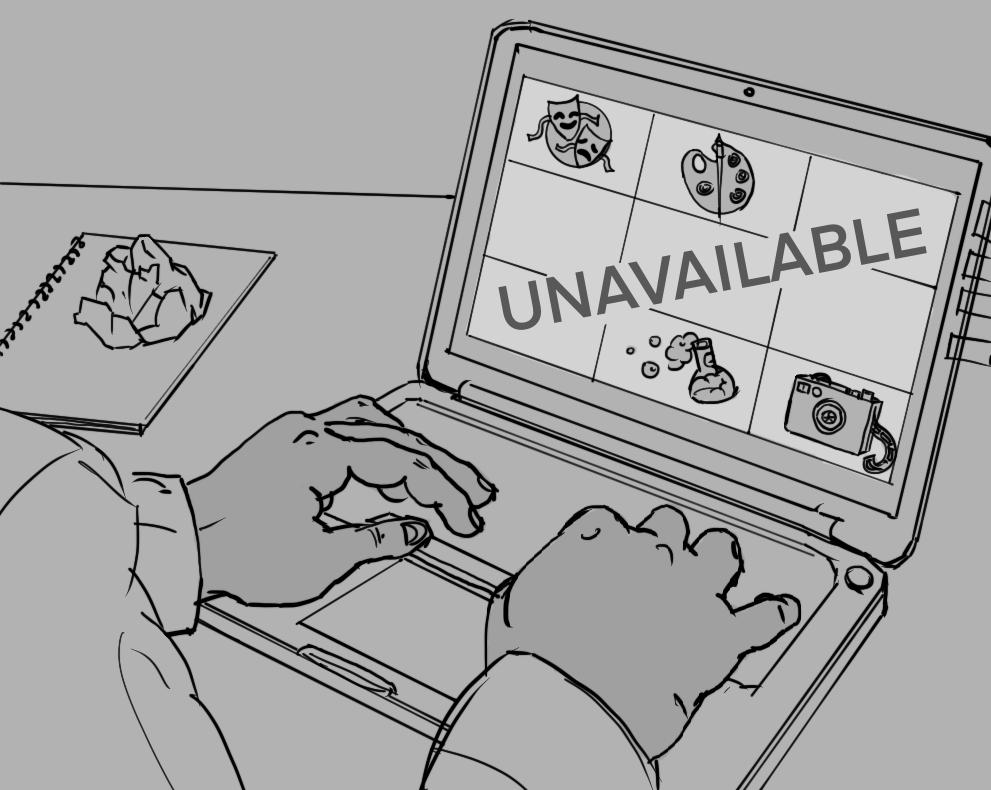 MICHAEL MAYEMURA
MICHAEL MAYEMURA
The sun never set on Lunar New Year
As the scent of pan-fried dumplings and the sound of boiling water envelop me in a cozy embrace, I welcome in the new year — the Lunar New Year. I eagerly await the heaps of lai see (red envelopes) and the bountiful hugs from doting aunts, goofy uncles, and the family matriarch, my Popo. The Lunar New Year has become a staple in my internal calendar; a time of odd superstitions, nostalgic scents, and a boisterous

the corruption and poverty in the countries to restore hope. Harris spoke to the president of Guatemala, Alejandro Giammattei, and they came to an agreement for Guatemala to receive $40 million to spend on education and further opportunities for Indigenous women and girls. However, when investigations revealed that Guatemala had not used the money following the lines of the agreement, there was no retaliation from the U.S.. This displays a common trend of the U.S.’s longrunning history of feeling obligated to provide haven for developing nations.
A country’s poverty cannot be solved if the people in power keep the money for their own pleasure. The U.S. specifically needs to concretely address where the $35 billion meant for foreign aid goes every year, and if the money is truly benefiting the country at large. A 2020 World Bank study found that a sixth of foreign aid that was intended for developing countries was moved into bank accounts in tax havens owned by wealthy people. The U.S. is not only giving away money to corrupt countries, but it is also doing it to gain more money and political power. U.S. foreign aid does not go to the countries with the lowest GDP (gross domestic product) per capita, but rather goes to countries such as Egypt, Jordan, Afghanistan, and Kenya. Those countries are supported due to their position in geopolitics and trade economics, not because of needed monetary support.
family. It is my connection to my heritage and myself beyond the traditional holiday season.
Just last month, California governor Gavin Newsom passed a revolutionary bill that officially recognized the Lunar New Year as a state holiday. It was hailed as a long needed step-towards inclusivity and praised by many, though you can count me out.
As a Chinese American, I cannot help but feel a little patronized by this “revolutionary bill”. Regardless of whether Lunar New Year is recognized or not, me and other Asians have and will continue to celebrate it.
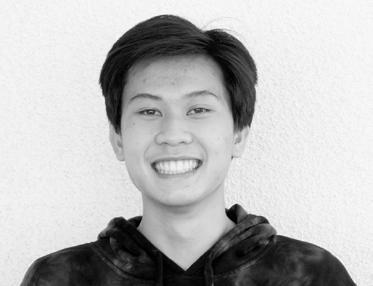
The law reeks of this “moral responsibility” that our government believes it has to recognize the plight of minorities and to uplift every minority to the same cultural status as the white man.
Lunar New Year is not meant to be a spectacle for the people of California to gawk at and is not some phenomenon that needs to be forced into the spotlight for all to see it is a means for me and my family (as well as many other families across America) to usher in a new year of prosperity and to be with one another.
Political and economic powerhouses give money to those countries to gain allies and goods, masking it with the intention of providing resources for developing nations. Foreign aid should help poor countries gain money to become influential and independent but instead it is used to boost already influential countries. Countries providing foreign aid must address the lack of transparency and proper attention given to the sums of money and resources given to developing countries.
I find this newfound recognition merely performative. The bill authorizes “any state employee to utilize eight hours of vacation, annual leave, or compensating time off in lieu of receiving eight hours of personal holiday credit to observe the ‘Lunar New Year.’”
In short, only federal employees have the luxury to use their vacation time as a means to celebrate their heritage, excluding millions of Californian workers, and adding us to the halls of insignificant state holidays (along Indigineous People’s Day and Cesar Chavez Day).
At long last, there is a reason for Newsom to be praised as some “woke” liberal and to absolve his hands of any wrongdoing, an opportunity for bigots in government to capitalize on a day meant to highlight Asian heritage, and a chance to win over one of California’s largest minority groups before the midterms. How could I not celebrate a bill that accomplishes so much?
Perhaps my views are too pessimistic. I am not against representation and I am certainly not saying my heritage should not be shared, but unsubstantial laws in its name does no good for anyone.
TIGER OCTOBER 20, 2022
Canceling advanced classes will only serve to deteriorate students’ declining mental health as the curiosity for learning wanes.
PAGE DESIGN ALLISON LEE 6 OPINION
The Tao of Sex
The influence of Western colonialism and institutionalized religion has made sex a taboo subject. But sex and sexuality have a deeper, “ancient Eastern” meaning.

STORY ISU PARK ILLUSTRATION ETHAN LYONS
Over recent decades, sexual freedom has become more conventional; sex is talked about in school, dating culture and hook-up culture exist hand in hand, and the media has presented characters who indulge their sexual identities. Finding empowerment in sex is a normal practice under modern terms. But the only reason sex had to be reclaimed was because of its lengthy, taboo-marked history. Intertwined with religion and colonialism, sex has strayed away from its natural meaning into something inappropriate and repulsive.
Sexual desire was condemned for its animalistic and unruly manner, so developing civilizations put laws in place to contain it, predominantly in the West ern world. Marriage as an institution is a prominent example of early attempts to maintain order in sex.
However, some religions capitalized on this by creating ad ditional rules – by using God as a threat – which granted re ligious leaders more power and authority over the people. On top of this, certain retellings of the story of Adam and Eve claimed that Eve had seduced Adam into sin, leading to a great amount of misogyny in Christianity, in regarding women as not only inferior, but as sexually uncontrollable.
Puritanism is likely the strongest perpetuator of this cul ture, in which Puritan colonization wrote it into law as they settled in America. Early American colonies sustained or der through public shame and sex crimes were especially forbidden. Moreover, the conditions that characterized the time period essentially reduced intercourse into only exist ing for its functional purpose, for babies powered the labor supply and colonies were in need of sustenance to survive.
Sex has been associated with shame and embarrass ment for centuries, not just in Christianity, but even tually in all major religions. However, ancient Eastern ideologies contradict such beliefs. Contrary to Western culture, the East has a history of being sex-positive. The principles of Eastern philosophy, specifically in Lao Tzu’s Taoism, center on wholeness, communalism over indi vidualism, and connecting to the body’s spirituality. It is a practice of fluidity and acceptance; the “tao’’, loosely translated to “the way”, is an ever-changing concept that is conditional to both the being and the circumstance.
Taoism removes the individual from feeling limited by societal and cultural networks, opposite from Western standards. Instead, it encourages the individual to seek salvation through their peers by advocating that shame should not exist, as everyone is human first. This allows people to appreciate one another on an intimate level.
Lao Tzu taught that there is beauty in balance and that there is an interconnectedness among all things. Two forces, take Yin and Yang, share a dynamic relationship; Yin is always transforming into Yang, and Yang is al ways transforming into Yin. A constant flow should exist between different entities in order to nourish life and to create harmony. Likewise, there is harmony in sex.
Smothered by centuries of change and the aggres sive institutionalism of celibacy and sexual indignity, this way of thought had mostly faded. In fact, sexu al liberation is relatively a newfound concept for the West. Through the work of progressives and in some cases, through the work of radicals, philosophies that mimicked the ideas of Taoism and other ancient be lief systems were integrated into Western societies.
Hippie culture in America, for instance, had bor rowed immensely from Eastern cultures in style, mu sic, and philosophies of freeness and peace. This contradicted notions of 1950s and early 1960s confor mity and conservatism, where sexual restriction and misogyny took the upperhand in American culture.
Sex has become an overcomplicated topic, and it has been politicized immensely due to its past. American history is marked with oppressive systems that have di rect correlation with restricting sexual liberation; for
instance, the push for comprehensive sex education still exists because of a conservative Protestant influence.
Professor Kristy Slominski of religious studies at the University of Arizona confirmed that abstinence-based education lobbied for by religious groups successfully gained federal funding in public schools over counter ing forms of progressive sex education. In other words, the censoring of sex and sexual freedom is so histori cally deep that it has an institutional burden to bear.
Being overt with sex and sexuality is important to bettering modern culture and politics, so it is im portant to encourage these conversations earlier on instead of the traditional, conservative approach.
Young people also have the time and freedom to explore the complexity of identity, and delving into what that means in regards to sex is a crucial part of this. As teen agers, practicing sexual openness could help one under stand oneself, one’s partnerships, and one’s humanness.
When valuing the principles of flexibility becomes a priority, all parts of life will begin to improve. Con trary to what has been historically taught in Amer ica, sex is a positive thing and can be supported by centuries of ancient belief. In the words of Lao Tzu, “the softest things in the world overcome the hardest things in the world. To be worn out is to be renewed.”
Hostile workplace standards stem from classrooms
STORY ELLIE NAKAMURA ILLUSTRATION ELLIE NAKAMURA

The precedence of toxic workplace culture induced a massive shift in the psyche of the modern workforce. More alternatives to the traditional lifelong career have led to a newfound ability to leave environments were workers feel underappreciated, unengaged, or simply unsatisfied. The sudden onslaught of unhealthy standards in professional settings can be credited to the competitiveness required to succeed within the education system.
Success is solely dictated by an individual’s impression on others, leaving students vying for approval from teachers
and peers. Whether it is adopting fake, agreeable personas or wasting time and effort on undervalued assignments to maintain perfect grades, students stretch themselves thin to stand out among the growing emphasis on image rather than integrity. However, such positive reinforcement creates the belief and expectation that pleasing others leads to success in the real world, especially the workplace.
When students are thrown into the working world, there is a clear lack of boundaries between work and personal life. The now-employees become stuck in a cycle of minimal reward for an unrealistic amount of effort, inevitably leading to burnout. Their ability to perform well is hindered by a state of crippling exhaustion.
The prioritization of mental health emphasized by the pandemic has brought about new ideas to the workplace. Gone is the idealization of tireless dedication in favor of “acting your wage.” Employees opt to treat their jobs with the same attitudes employers treat their workers. While the intent is to demonstrate value in personal life, this mindset creates a snowball effect: a drop in economic productivity leads to a decrease in resources which causes societal havoc. While there is not a clear solution to ending such a destructive cycle, strengthening communication in the workplace can help management address emerging issues.
A lack of boundaries is evident through the prevalence of student burnout. Workplace-esque standards have been established in the academic competitiveness that pushes students to neglect their health. Students are expected to complete tasks without regard to personal wellness, outside commitments, and familial affairs with the threat of failure looming over every assignment. Combined with a large student body, standing out becomes impossible with only academic excellence. This deficiency must be accommodated with extracurriculars and external connections. Similar to the professional world, a connection to an employer can influence possible promotion and better treatment. Establishing a relationship beyond the workplace standard enforces that pleasing those in power will lead to future success.
Administrators are responsible for amplifying student voices and supporting them in and out of the classroom. Whether it is putting more students in effective roles within the district or identifying when they are working harder than necessary, stopping comparative behaviors early on and empathizing with the student body is critical in preventing burnout. This would improve the pressure for students to behave in an agreeable way with teachers. Long term, students grow up knowing success is impossible without the conservation of personal wellness. In this way students can be taught to recognize environments that respect them and promote healthy workplace culture.
TIGER OCTOBER 20, 2022
PAGE DESIGN ALLISON LEE 7OPINION
Late Start Days & Its Effect
South Pasadena High School uses a block and late start schedule, one that yields various uses for both students administered a survey gathering opinions and testimonials from the student body and investigated the history well as examined how beneficial later start times prove to be for faculty and
Students speak on late start days
Classes begin at 9:45 a.m instead of 8:30 a.m. for late start days at SPHS roughly twice a month. Teachers and staff members are often tangled in department and faculty meetings in the mornings, but the practice yields unique uses of time for the nearly 1,500 students on campus.
In a survey conducted by Tiger, out of the 547 participants, 95.4 percent reported that they find themselves looking forward to the biweekly Late Start Days, and 80.8 percent reported that their days look different for them than typical school days.
A variety of activities were reported with 49.2 percent of students sleeping in each late start day and 18.6 percent of students spending the morning studying or doing homework before the start of classes. Another 11.2 percent responded that they most often get breakfast or hang out with friends, four percent stay up later the night before, and about three percent of respondents attend practice for an extracurricular with the extra time they have in the mornings.
“I have a lot more time to make a good breakfast, make a good lunch, and relax during my morning,” one senior said. “I [feel] very awake [at] school on late start days.”
Of the participants in the survey, 95.4 percent also reported that they felt that late start days are beneficial, and even necessary for students.
“Not only are they necessary, they give students more time to sleep in, which decreases stress levels, at least that is how it is for me,” one senior said. “I also get to catch up on any homework assignments that I forgot to finish which ultimately increases my overall grade which I think is a necessary thing.”
An additional 82.9 percent reflected that the biweekly practice has benefitted their sleep schedules, but an estimated 12 percent of contributors reported that the schedule changes did not benefit their continuity and quality of sleep.

“Some late start days set up a good sleep schedule for the week to follow,” a junior said. “But other times, depending on the workload, I just end up staying up later, getting the same amount or even less sleep than usual.”
Students also reported that the practice of late start days in the schedule gave them a chance to recharge, but did not necessarily reflect a comfortable distribution of time during the week. Numerous participants cited that they felt that the Tuesday/Wednesday schedule disrupted the flow of the school week and called for later start times towards the beginning or end of the week. Some students also cited that they felt that Late Start days should be more frequent, some even up to every day of the school week.
“Honestly I wish late start was every day, but I think a more realistic desire is if on late start weeks, we get them on Mondays too,” another junior said. “I am very grateful [for] them.”
The shift in start times is used in diverse ways that may be beneficial to students, but as vocalized by the student body, there remain improvements that could be considered for the late start program at SPHS.
Late starts truly are something to look forward to, especially during hard weeks. It is really nice to know that I will have some extra time in the week to work on different things. For me, a late start is less about getting more sleep and more about being less stressed.
Late Starts foster
On alternating Tuesdays and Wednesdays, students gather continuation of SPHS’ history of late starts. Coffee aficionados coffee and conversation while others at home enjoy a little populate the classrooms of their respective departments
With a plethora of options to choose from, students often teachers, they provide valuable time for faculty collaboration.
“[Late starts] came along in kind of a discussion about, teacher Joshua Whitney said. “[They came along so] do outside of the classroom.”
Late starts are nice because they allow me to sleep more and have more time to enjoy life.”
Do you find yourself looking forward to late starts?
(95.6%)
(2.4%)
(2%)
Besides receiving designated time for collaboration, environments. In social science teacher Annalee Pearson’s how late starts change the classroom environment for
“[Although] 50 minutes does not seem like much, it creates my perception, but I think that the class usually has better
While late starts are a breath of relief to students, accommodate a later start time, teachers find themselves These modifications can manifest into bigger problems. regularity.
“Late start days are complex, like everything else [around said, “There are things teachers have their eyes on that of momentum. I always thought that was the case before

Late starts often get tangled in the complicated discussion evaluations at every grading mark to engage in dialogue evaluation, she noticed a trend - 80 to 90 percent of responses
“That is a concern, both as a mother and also as someone the same thing over and over again and wishing it will produce changing in terms of post pandemic stressors, traumas,
While late starts provide crucial time for teachers to meet, struggling student. Instead of a one-size-fits-all remedy,
TIGER OCTOBER 20, 2022
Yes
Neutral
No
“ ”
“
8
Effect On Students & Teachers
students and teachers on campus. This month, Tiger history and intentions behind the unique practice, as and students.
foster collaboration
gather around the tables of local South Pas cafes in a aficionados opt for the lines at Starbucks and Jone’s for little extra time in bed or sob into piles of paper. Teachers departments to debrief and plan ahead. often look to late starts for a break in the monotony. For collaboration.
about, as I remember it, teacher time,” SPHS Spanish so] teachers can have the time to do everything they
collaboration, teachers often notice a change in classroom Pearson’s 15 years of teaching at SPHS, she has seen for the better.
creates a noticeable difference. I do not know if it is just better energy in some way, shape, or form,” Pearson said.


administering them can be a hassle for faculty. To themselves modifying lessons to fit a shortened instruction time. problems. For Whitney, this problem involves a disruption in [around here]. They are a multifaceted problem…,” Whitney I think students do not as much. One of them is a kind before COVID hit, but once COVID hit, I really value it now.”
discussion of student wellness at SPHS. Pearson conducts selfwith students about their mental health. In her last selfresponses either alluded to or mentioned the word “tired”. someone in this profession,” Pearson said. “Insanity is doing produce different results. It is just the truth. With times traumas, and habits, how do you get better?”
meet, they also serve as pressure release valves for the remedy, they present benefits and setbacks.
GRAPHICS ALLISON LEE & ELLIE NAKAMURA
ILLUSTRATION & PAGE DESIGN ALLISON LEE
The development of later start times at SPHS
SPHS ran on an all-day schedule before Principal Janet Anderson’s arrival in 2000. However, during the three years prior to the shift to late starts, former SPHS assistant principal Jack Smith spearheaded committees that evaluated different schedules and start times. The committees were composed of students, parents, and teachers that attended high schools in the surrounding areas.
Administration drew the conclusion that a block schedule would most benefit students and teachers. With this schedule shift, late starts were introduced — focused on allowing teachers to have professional work time that did not take instruction away from the allotted school day.
The Teachers Association of South Pasadena (TASP) played a large advocacy into the implementation of late starts.
“They wanted to stress that TASP was a professional organization, when we did implement late starts, that was one of their premises, teachers are professionals, they need their professional time,” Anderson said. “With four late starts a month, the idea was that they would be back to back to make it best for students and give teachers more time to exercise professionalism to make sure things were coordinated well for students.”
Late starts have been in effect at SPHS for the past 22 years. School begins at 9:45 a.m. instead of the typical 8:30 a.m. start time roughly four times a month.
“One late start a month is supposed to be directed towards faculty meetings, and basically it is like business, it is announcements,” Principal John Eldred said. “It is like we are going to now do this, or how does everyone feel about that.”
A second late start provides a time for department meetings, a third is directed for collaboration time between teachers and departments, and the last late start is for teachers to have independent work time to finish grading tests, phone parents, or finish lesson planning.
Faculty now use staff meetings to discuss and prepare for the Western Association of Schools and Colleges (WASC). WASC visits assess schools ranging from prekindergarten to colleges and universities, accrediting them for meeting educational standards every six years.
Teachers gauge student performance and compile information into reports for WASC, influencing the structure of faculty and department agendas for the accreditation process.
Additionally, staff use their time to best accommodate their individual needs. For instance, late starts have provided the Physical Education Department time to clean out lockers and athletic changing rooms. Other departments also use late starts as a time to prepare for state testing and other benchmarks, discussing adoptions of new textbooks, or hone into a tighter focus on their curriculum.
STORY HANNA BAE, ANIKA EBBERT, & LINDA YUN
TIGER OCTOBER 20, 2022
What do you do on most Late Start days? Sleep in (49.2%) Study/do homework (18.6%) Get breakfast/hang out with friends (11.2%) Stay up late the night before (4.4%) Attend extracurricular (3.1%) Other (13.5%) Normally, late start days are the best days of my week. “ ” I love late starts, extra sleep helps me stay more focused and ready to learn in class. “ ”
9
A new world of art through AI
New AI technology stretches the limits of human creativity.
STORY MORGAN SUN ILLUSTRATION ISOLE KIM
Anew medium of art has arrived in a pumpkin carriage of controversy. Different forms of artificial intelligence creative art have been crossing the pages of TikTok this year. But for the first time, a piece of art developed by an AI bot was put on the cover of the Cosmopolitan magazine in June of 2022, and another won first place in an art competition during August.
While some are threatened by the possibility of the takeover of artist jobs, others seem to see this development as a new medium to explore. No matter where one stands, it is impossible to avoid the reality that AI systems have arrived to the realm of art.

These AI generated art pieces use text-to-image applications and sprawling databases of existing imagery to convert a written prompt into an instant new picture. The most notorious application at the moment is DALL-E 2 from the artificial intelligence research laboratory, OpenAI. Their products can be astonishing, from realistic space scenes to fantasy islands.
Artworks that would take a professional artist hours and days to achieve can be completed within a couple seconds for an artificial machine.
The newly released technology has reported up to a million public users, but the fascinating images leave some unsatisfied. The created image is not perfect, with saturated edges, unclear objects, and distorted details popping up the longer it is viewed.
The confusion in the nascent AI art ultimately lies in fear, as the unknown so often does. After Jason Allen’s firstplace win at the Colorado State Fair with AI generated image Théâtre D’opéra Spatial, controversy predictably sparked within and outside the art community. Critics argued that the image was not art at all, and others insisted that this marked the beginning of the replacement of true
art. Human struggle is essential to the validity of artistic expression — people can dare to take risks, AI cannot. While humans fret about the barrier to imagination, AI compiles, sifts, and analyzes data sets to execute its product. The resulting art is adequate, but not as poignant as the toils of human labor.

But this is not the first time controversy has reared its ugly head against mediums of art. The same fear of AI art began in the rise of photography. Charles Baudelaire famously called photography the “mortal enemy” of art — but decades later, photography is one of the most widespread means of creativity.
The idea that art must be within the bounds of human handicraft is beyond ludicrous in this day and age. It is clear that in hindsight, machines did not replace art, they only expanded upon it. AI is not going to replace creativity, it will only reconfigure the nature of expression.
However, machine generated art has also blurred the lines of ownership of the certain style of art. The US Copyright Office has ruled that AI-generated art is not subject to copyright law, as the protection is only granted to work created by the human mind.
Requiring human authorship for copyright protection means that, under current laws, AI generated art does not have an owner.
Be that as it may, the AI art still exemplifies more benefits than drawbacks. Using the applications to generate instant feedback for a certain idea can stretch the imagination beyond human limits, allowing more breadth and exploration early in the process to aid final creative outputs.
Fear of the unknown is a natural human response, but in a decade, kids of the new generation will grow up with this technology as their norm. Reconfiguration, not originality, is the essence of art, and it is time to adapt to the tools of the future.
Charlotte’s Web
CHARLOTTE
DEKLE

They did the M*A*S*H
Although no self-respecting teenager would care to admit this, I love the television show M*A*S*H. The tone just puts me in a sweet lull of watching people in the past crack finely-tuned witticisms at each other, but it also satisfies my hankering for intense drama. Not only did it cement my fascination with “old media,” it represented a period of unity in American history that we will never recapture.
M*A*S*H follows the escapades (and sex-capades) of doctors and nurses in the 4077 Mobile Army Surgical Hospital in the 1950s during the Korean War. M*A*S*H changed the television landscape by essentially inventing the dramedy by blending comedic moments with the true horrors of war.
Anyone who knows me knows that I enjoy media from before my time. But my obsession with shows like M*A*S*H may have stunted my interpersonal development. Since I naively assumed that people would be interested in a show from 1972, I found it difficult to cultivate friendships with people my own age. In fact, most of you have probably stopped reading because you do not care about this show.
Even without watching television shows from decades before my birth, I never felt like I could fit in among my peers and for some unexplainable reason, that separation drove me to immerse myself in this media more. In some subatomic part of my being, I wanted to be different. I wanted an excuse as to why I did not go to dances or hang out with friends. It just seemed easier to laugh and make friends with the cast of a show from the 70s than with my classmates.
But M*A*S*H was more than just a show, it was a cultural phenomenon. Sandwiched between Super Bowls, M*A*S*H’s finale is the most watched in television history, with 106 million U.S. viewers tuning in. When the show wrapped, the creators and leads received letters of congratulations from then-President Ronald Reagan and formerSecretary of State Henry Kissinger. This kind of unanimity was all the more impressive given that it was a politically divisive show. Nowadays, a show like M*A*S*H would be written off as ‘liberal propaganda’ and Tucker Carlson would spend hours bloviating about it on his show.
The 11-season-run spanned four presidencies and a myriad of cultural and political moments. It ran through an especially turbulent time in history. Other than the Vietnam War, M*A*S*H viewers are the same who witnessed Watergate, the Iran hostage crisis, the establishment of the Departments of Energy and Education, and the beginnings of Iran-Contra.
M*A*S*H brought America together for half an hour each week and for two and a half hours for the finale. Since non-streaming television phenomena have ostensibly ceased, we will never have another M*A*S*H. We will never have the same national unity that came from everyone sitting at their box television sets or crowding in a local bar to watch our favorite ragtag group of army doctors again. I mean, unless the NFL starts putting football players in scrubs and gives them scalpels. I guess all we have left is the Super Bowl.How scary is that?
TIGER OCTOBER 20, 2022
PAGE DESIGN ETHAN LYONS 10 FEATURE
The misogyny in Tex Avery’s defunct cartoons
 STORY CLEMENTINE EVANS ILLUSTRATION ISOLE KIM
STORY CLEMENTINE EVANS ILLUSTRATION ISOLE KIM
T ex Avery was a filmmaker, producer, and voice actor from the early 20th century, remembered for his cartoons that dominated the golden age of American animation and now iconic characters, such as Bugs Bunny and Daffy Duck. Despite his prevalence, Avery created several misogynistic movies with sexist themes that continue to persist in present society. His protagonists and main characters had similar attributes of howling at attractive women. Although Avery’s cartoons did not invent catcalling, the sheer popularity of his style promoted the misogynistic habit into current culture.
The director’s films were targeted toward young audiences, hence the childish animation and foolish characters. Since children’s films are supposedly innocent with no hidden messages, aiming these cartoons towards youth normalized catcalls and deemed them acceptable. Kids were taught at a very young age that the behavior modeled in Avery’s movies was appropriate.

Avery’s short films such as Red Hot Riding Hood, Little Rural Riding Hood, and The Shooting of Dan McGoo portray female leads through a sexual lens of physical appearance and behavior. The main protagonists in several of his movies howled at female performers, furthering the idea that women are objects to be ogled at. In these scenes, women dressed in low-cut outfits dancing on a stage for male enjoyment. This propagates the idea that women merely exist as sexual objects for men, stimulating harassment such as catcalling. These habits hold out into modern society with his cartoons still being ubiquitous with childrens’ programs on Saturday mornings, continuing to establish and normalize these notions in a setting far removed from the time which these were created.
Little Rural Riding Hood is a quintessential example of Avery’s sexist themes. The movie highlights men not only fantasizing about sexual assault, but continuing their aggression after women have voiced their objection. The cartoon normalizes a significant trend of sexism and abuse that is not explicitly denounced. In the start of the film, Country Wolf is the classic ‘wolf in grandma’s bed,’ but instead of the traditional craving to eat Red Riding Hood, he would rather, as he puts it, “chase her and catch her and kiss her and hug
her and love her.” Country Red, the Little Red Riding Hood knock-off of the movie, sprints away from the wolf but eventually gives in to his continuous harassment. Instead of showing the wolf accepting rejection and walking away from the situation, Avery shows the wolf continuing his aggression and pursuing the girl after a clear and concise turndown.
The violation of women through lack of consent is representative of modern sex and rape culture, which calls attention to men dismissing womens’ refusals. Seeing positive depictions of catcalling and men winning out against reluctant women exemplifies why men feel it is acceptable to continue harassment even when women are signaling their discomfort.

Animaniacs, another show influenced by Avery, is about three siblings: sister, Dot Warner, and her two brothers, Yakko and Wakko Warner, notorious for causing mischief around the Warner Brothers Movie Lot. This show created the famous line, “Hellooooo nurse!” which is a catchphrase used when the two brothers see a good-looking woman. The brothers continue this throughout the series without being rectified or stopped. The women who are being called out either
run away or put up with sexist and abusive behavior. Yakko and Wakko were viewed under the notion of being fun and energetic children who happened to compliment attractive female roles in an innocent way. These gestures were normalized throughout the show and while this was a valid cause for protest, it was not acted upon by audiences.
Avery’s work promoted aggression towards women by men by showcasing suave characters constantly demeaning the women around them. This was a common trend equipped by those who controlled the media at the time; however, due to Avery’s immense proliferation, his lasting impact is one that must not be overlooked. He has promoted these ideas by including them into his movies and therefore pushing them onto audiences.
It may not have been Tex Avery’s intention to make endangering the safety of women a sizable part of his cartoons, but it is undeniable that the pervasiveness of catcalling and harassment within his shows still impact modern discussions of sexism and misogyny.
TIGER OCTOBER 20, 2022
PAGE DESIGN ALLISON LEE 11FEATURE
The societal ills and chills of horror villains
 STORY MORGAN SUN, JAYDEN TRAN, & ROSE VANDERVELDE
STORY MORGAN SUN, JAYDEN TRAN, & ROSE VANDERVELDE
Tethered to America’s classist political climate
Presented as the antagonists of Jordan Peele’s Us, the Tethered are residents of an underground secondary world, serving as mindless doppelgangers to the individuals who thrive above them. The Tethered are a population of citizens represented as a government project “gone wrong,” that alludes to a larger issue plaguing the current political and social worlds of the country: xenophobia and class-based division.
The film highlights how classism and inherent prejudices within the nation create a division in America between immigrants and American citizens. The movie serves to narrate the ideas that arise in the everyday individuals in America living through the current political climate. The population of Tethered represents the shadows cast by the clashing of morality, pride, and politics.
“The feeling that we all feel we are the good guy in our own story prevents us from facing our demons,” Peele said in an interview for the Los Angeles Times. “I wanted to make a movie that allows everybody to face their demons, in whatever faction you want to put this movie through the prism of. But as a starting point ... the United States and our xenophobia was the front and center idea.”
The Tethered serve to showcase how one’s political beliefs can differ heavily in comparison to their actions. Throughout the film, the Tethered are shown to be brainless and unable to act without orders. This can be observed through the overall story and is represented by the tethers, who are perceived as under those who live on the surface. This is a direct correlation to the American socioeconomic world, in which individuals who are above others in class serve as leaders in the world while those who are under are oppressed and not provided with an equal platform.
The main message revealed from the plotline of the film focuses on a separation between those who thrive above others and those who work at the bottom of the general public. This idea is only further developed through the conflicts that arise between the families in the movie and their tethers. The connection between the above and the below is similar to the clash of the rich and
Pig’s blood, pressure, and punishing behavior
Carrie is a film so popular it needs no introduction, but her dire tale is overshadowed by the epitome of stigma following abuse. Based on the novel written by Stephen King, the story follows teenage girl Carrie White as she tries to navigate the treacherous waters of high school. The tragically shy and repressed teen faces abuse and maltreatment in all facets of her life, both at school and home.
From the first day of school, she is constantly ridiculed and shunned as “different.” Tensions peak when the main antagonists, Christine “Chris” Hargensen and her boyfriend Billy Nolan, rig the prom election so that Carrie wins prom queen. The first light of true joy enters Carrie’s eyes when she wins, but is immediately doused by buckets of pig’s blood raining on her parade. This act is the final straw for her, leading her to unleash her telekinetic powers on the entire school. As the horror villain, her turn to violence only affirms the association of abuse and escalating brutality.
Carrie’s home is no sanctuary. She lives with her fanatically pious mother, who acts as if everything Carrie does is a sin. Carrie develops her telekinetic powers at the same time as her first period — emerging into her femininity so to speak — but is ostracized by her mother for the wicked event. She gets beaten and thrown around constantly, her mother ensuring that Carrie never finds a safe place in her house.
The audience spends the entirety of the movie sympathetic towards Carrie, particularly considering her early tragedy. But as the ultimate anti-heroine she is, the conflict arises when she loses control of her abilities and endangers fellow students and teachers in the process. Murderous rampages, no matter how driven by abuse, are unforgivable. But what must be acknowledged is society’s damaging tendency to overlook abuse until it festers into an uncontrollable rage.
Even if Carrie’s actions were accidental, the people around her would still think it was purposeful — the retribution of an abused girl who cracked under the pressure. The movie represents humanity’s purported link between abuse and violent criminal behavior, because that is the core plotline of the film:
Set in direct contrast to the upstanding Doctor Jekyll, Mr. Hyde is a physical misrepresentation of mental illness, specifically Dissociative Identity Disorder (D.I.D.. The inaccuracies of his portrayal of the illness contributes to the stigmatization of mental disorders.)
In Robert Louis Stevenson’s gothic horror novel Strange Case of Jekyll and Hyde, the extreme dynamic between the two main characters connect their individual actions to their personal mental struggles.
In the book, Jekyll makes references to the duality of a “public” face and “home” face. He associates guilt with actions such as a drinking habit, and casual relations that are part of his “home” face, which he hides from the rest of society. As he feels his actions are not in line with his construct of acceptability, he is troubled by guilt.
To acknowledge this would signify a crack in the flawless mask of his “public” face and thus he is consumed by this guilt, trapped in a moral dilemma which he distracts himself from through a cycle of drinking and regret. This ties back to the misunderstanding, and subsequent worsening of mental illness, which is a part of the stigmatization surrounding the illness.
In order to find a guiltless outlet, he delves into the
“darker sciences”, creating alter ego, Mr. Hyde, in the process. Jekyll soon develops the need to become Hyde. This the beginning of the development of D.I.D. in Jekyll, as Mr. Hyde is the other identity that Jekyll takes on.
As the book develops, Jekyll grows more and more addicted to the “freedom” of the transformation he undergoes into his alter ego, or the progression of the illness.
D.I.D. is the most exemplified obstacle that the JekyllHyde duo face. The void between the two personalities is represented in not only actions, but physical appearance. Hyde is physically different, shorter, hunched, and described as hideous when seen by other people, as opposed to the taller, more average-looking reputable scientist Doctor Jekyll. When seen, Hyde’s very presence is described as “evil” by other members of society, and seems to reflect his personality.
The good and evil dynamic again comes into play in the actions of Mr. Hyde. As Hyde is “completely” evil, his actions reflect the lack of moderation. Without conscience or morality the “good”, he is free to wreak havoc. The connection between Hyde’s murderous actions and the two separate personalities, D.I.D, is quickly drawn.
The negative association between Jekyll and Hyde’s representation of D.I.D and Hyde’s violent actions lends itself to harmful stereotypes about this condition. This connection is representative of the larger societal ill of stigmatization of mental illness.
Those with mental illnesses are not inherently dangerous, but often misunderstood. The general public’s lack of knowledge of mental illness, not those with the mental illness themself, encourages stigmatized portrayal.
There are no “set” symptoms of mental illness and each individual’s experience is different. The idea that all mental illness causes the same behavior, a behavior which changes morality and conscience such as that displayed by Hyde in the novel, is false. Ultimately, this belief can be traced back to a lack of knowledge surrounding mental illness.
The societal ill of stigmatization of mental illness is wrapped up in Hyde’s violent behavior throughout the novel, and is present through parallels drawn between his actions and representations of D.I.D within Jekyll and Hyde’s dynamic.
TIGER OCTOBER 20, 2022
The duality of dissociation: Jekyll and Hyde compares mental illness to violence
ILLUSTRATION ELLA MIZOTA-WANG PAGE DESIGN ALLISON LEE
12 FEATURE
TAAGLAA: “Life Cycle” Exhibition
TIGER’S AWESOME ADVENTURES IN THE GREATER LOS ANGELES AREA
6801 Hollywood Blvd, Los Angeles, CA 90028. Open 11 a.m7 p.m. Monday through Friday and 11 a.m. - 8 p.m. Saturday through Sunday.
Exhibit will be on display until January 15, 2023. Admission for all ages - free
STORY LINDA YUN PHOTOS SAMANTHA SHIROISHI
The pulse of L.A.’s rich film and entertainment industry lies in Hollywood Boulevard. From sunrise to sunset, visitors and vendors up to the thousands pump life into the city. Oversized parasols lined the sidewalks, providing shade for street vendors of all mediums – from souvenirs to diced tropical fruit.
While Samatha was busy at another shoot, I explored Downtown on my own. I started my adventure at the Hard Rock Cafe to check out some rock-and-roll memorabilia. After being thoroughly fascinated by the fact that the cafe was not just another overused hoodie design, I stepped into the streets.
A stairwell led into a cylindrical shopping center. After ascending a rivulet of stairs, I turned to face the exhibit. The name of the exhibit, LIFE CYCLE, is emblazoned at the center in emerald Serif text.
The exhibition, Life Cycle, examines the artistic lineage of fourth-generation bamboo artist Tanabe Chikuunsai IV. While continuing his family’s tradition of weaving smaller sculptural works, Chikuunsai is renowned for his life-sized contemporary installations.

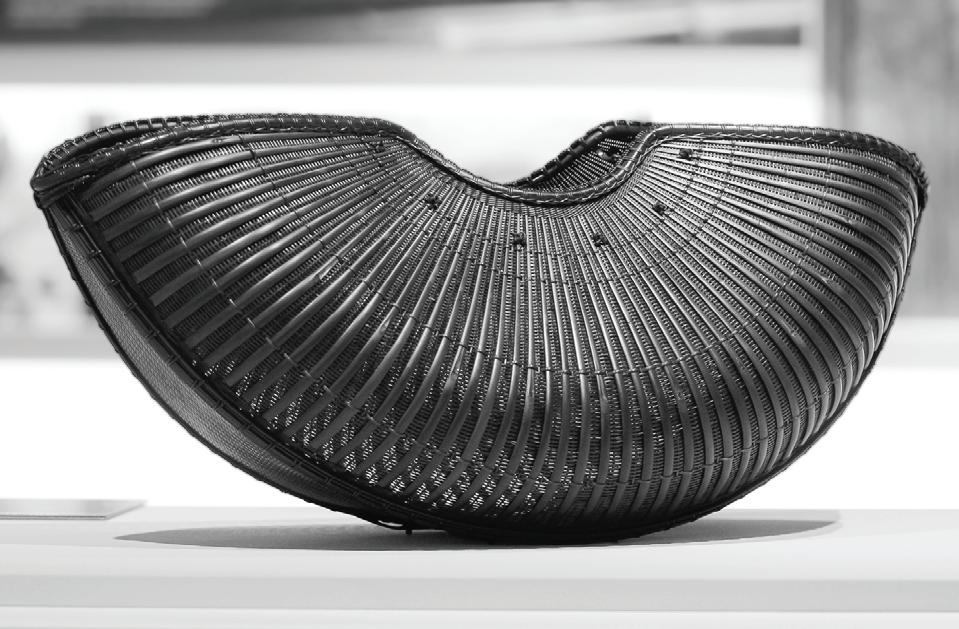
A cross-hatching of bamboo strips surrounded the text in the shape of a heart, which coiled into a chubby artery. Affectionately named “The Cycle,” this piece is symbolic of regeneration – a literal representation of the human heart and its bestowal of life into every creature on Earth.
Tanabe Chikuunsai IV creates contemporary artworks that fill entire venues across the world. Using madake (timber bamboo), kurochiku (black bamboo), and torafudake (tiger bamboo), his works often feature large
scale installations in twisting woven forms. Chikuunsai comes from a lineage of bamboo masters, starting from his great-grandfather, Chikuunsai I.
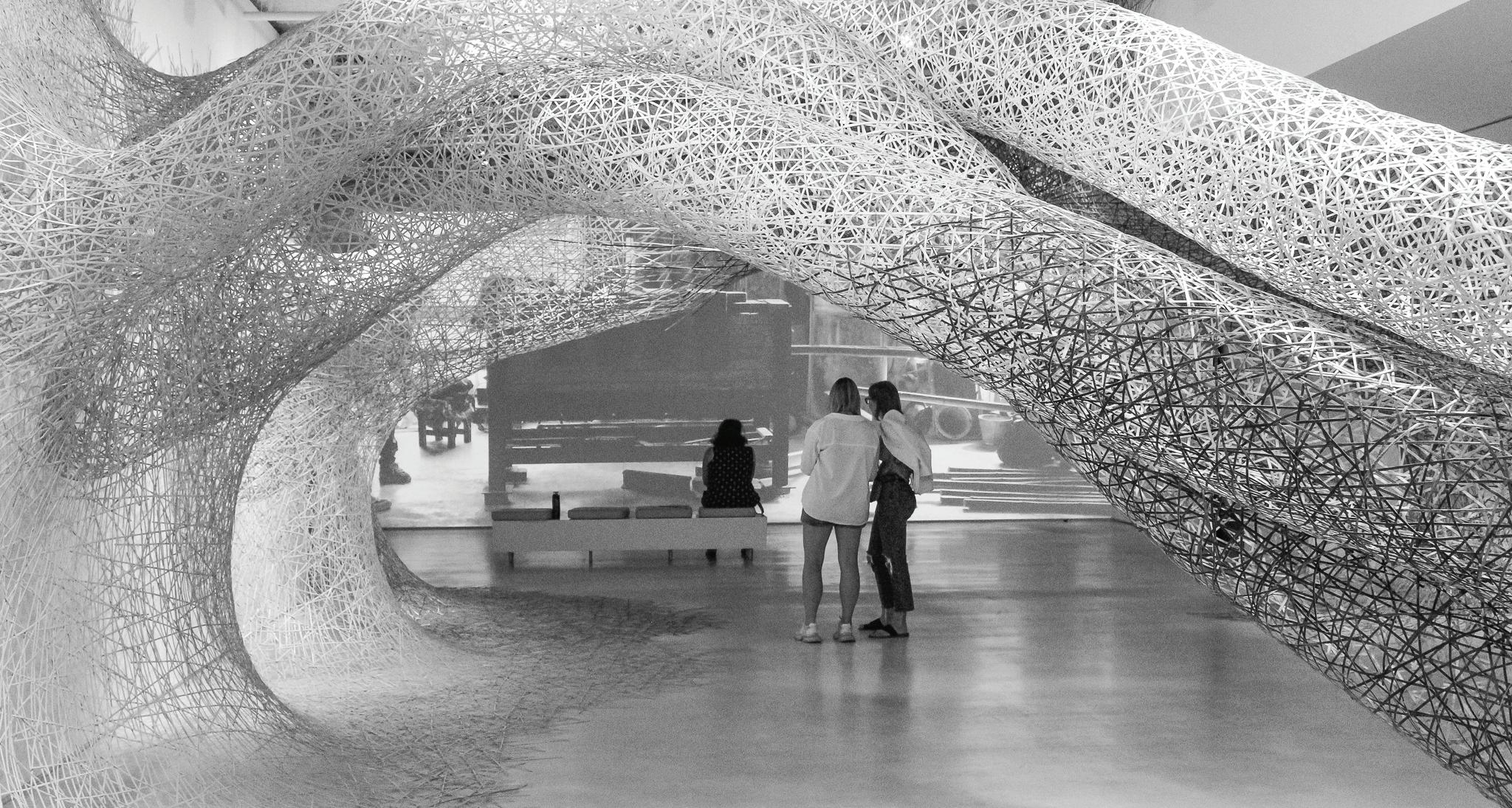
The origin point of the exhibit featured various smaller works of the four Chikuunsai generations. Tanabe Chikuunsai IV’s grandfather, Chikuunsai II, frequently used bamboo roots in his work. Bamboo roots differ from mature bamboo poles in their texture. For Chikuunsai, they represent the strength of life. He embraced the challenges of working with a more rugged material and carved the otherwise unusable roots into bamboo strips. At around a millimeter in width, the strips can be woven into baskets and other smaller structures.
After roaming the exhibit for what seemed like hours, I had yet to witness the encore. When I entered the exhibition room, my only regret was that I didn’t go in sooner.
Chikkuunsai’s largest work of Kikkōami (turtle shell weave) began with a madake bulb forming a hexagonal shape on the right window. I peeked through it to find a network of threads hatched across a woven basket. Before visitors can notice the bulb expanding, it separates into three tunnels. Among the three, only two overlap at the two points of intersection. The first point came with a change in wood, from pure madake to a blend of kurochiku and torafudake, both of a noticeably darker tone than their predecessor. The two tubes on the bottom wrestled with each other before touching the wall. Upon making contact, the inside layer forms a nub against the while, while the outer layer widens and sprawls out in a web across the wall for reinforcement.
I walked around to the base of the second tunnel when I saw that it begins where the first ends. Traversing upward at an angle, the tunnel stretches towards the
chute coming down from the other end. Before the two tunnels could meet, the Kikkōami ends, leaving a gap that would otherwise be closed. This gave the midsection a snapping effect, marking the undoing of one perfect tunnel. For the artist, the gap was meant to symbolize the necessity of getting back into the cycle, even when it seems to be falling apart.
Chikkuunsai’s theme of cycles extends into his artistic practices. Bamboo grows quickly, making it a reliable natural resource. With the support of his crew, the artist reuses up to 90 percent of bamboo in previous projects. The remaining 10 percent is only disposed of because of irreversible adjustments from installation.
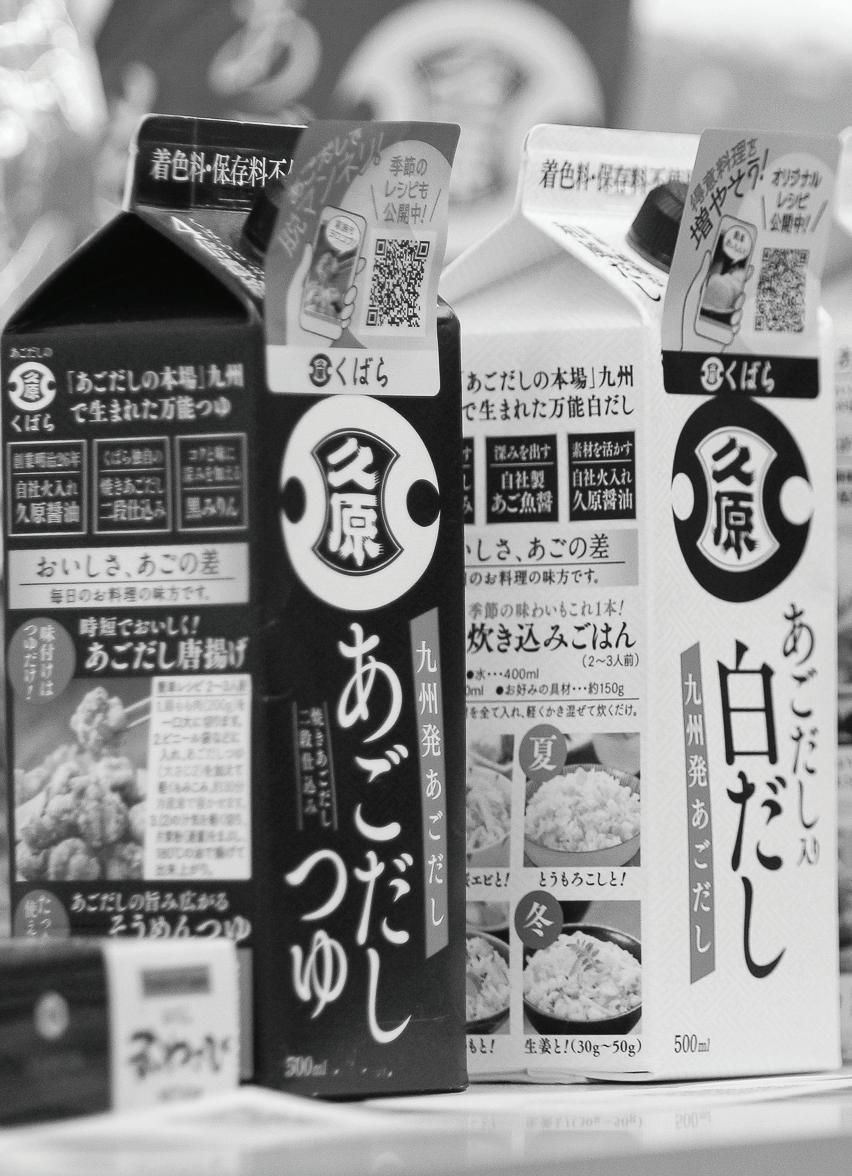
The third tunnel wraps around the left corner to form a smaller bulb, which caves into itself to model the inverted silhouette of a raindrop. Then, when the basket separates, the newly-formed tubes loosely twirl for a short distance before winding up at another wall. This time around, the tubes don’t close off as they meet the wall; they open and flatten. While the artist doesn’t specify the reason behind this decision, I speculate that he aimed to create a full-circle moment, since the first basket began with an open end.
From the eccentric motorcycle stunts on Hollywood Boulevard to the twirling tunnels of Chikkuunsai IV’s installations, the two hours in Downtown LA were two hours well spent. A remarkable push against the boundaries of traditional Japanese bamboowork, Chikuunsai’s innovation is a testament to the everexpanding realm of contemporary art. I left with a better understanding of Japanese culture, albeit at the cost of my aching feet.
LOCATED ON HOLLYWOOD BOULEVARD, Japan House of Los Angeles showcases the work of Tababe Chikuunsai IV’s life-sized bamboo scuptures.
TIGER OCTOBER 20, 2022
PAGE DESIGN ALLISON LEE
13FEATURE
Football gears up to face Pasadena Polytechnic High School at historic Los Angeles Coliseum
Jackson Frecking said. “I think it’ll be a fun game against Poly, we’ll definitely come out on top.”
Because of the historic implications of the Los Angeles Coliseum, the team has taken special considerations for the match against Pasadena Poly.
The South Pasadena pep team have begun their preparations for the game alongside the football team. After the celebrations of senior night following the Homecoming game on Friday, Oct. 7, the LA Coliseum game will be one of the most significant events for the pep squad for the rest of the football season.
“We just had our last home game and senior night, so this gives us something big to look forward to and work towards,” senior Commissioner of Spirit and Varsity Song member Kaile Fernandes said. “We’ve never had the opportunity to perform at a large venue like this, so we want to look our best.”
STORY JAYDEN TRAN ILLUSTRATION ETHAN LYONS
Nearing its 100 year anniversary, the Los Angeles Coliseum has served as a stadium of significance for LA sports teams throughout its history. The stadium is known for a capacity size of 90,000, rivaling that of stadiums such as the Rose Bowl. The venue was built for the Los Angeles Olympics where the four-year event was held twice, and since, has been used for teams such as the Los Angeles Rams and Dodgers in the past, and is currently the home stadium for the USC Trojans. The South Pasadena Tigers are gearing up to play against the Pasadena Polytechnic Panthers at the Los Angeles Coliseum on Thursday, Oct. 20.
Pasadena Polytechnic does not have a suitable football field for their home games, and often rent out facilities to play at for their football games. With Pasadena Poly being
granted permission to play at the stadium near the end of the 2021-2022 school year, South Pasadena’s football team has been preparing to play at this specific stadium since summer training.
“This year, they were able to rent the LA Coliseum for this matchup,” Athletics Director Anthony Chan said. “We agreed to it, and it would be a great experience for our student-athletes, fans, and community to play in a historic coliseum.”
Playing at the Los Angeles Coliseum is a large shift in venue for the South Pasadena Tigers, who typically play games at Solari Stadium, which seats about 1000 fans at most. With this change in field, the South Pasadena football team have been heavily anticipating the upcoming game.

“The team found out we’d be playing at the Coliseum since last year, so we’ve had a heads up for a while,” quarterback
The pep squad seniors, specifically, are looking forward to the upcoming match against Pasadena Poly. Cheering at a larger venue such as the LA Coliseum will establish the squad and promote the team for future events on this scale.
“Cheering at a field of this scale is a whole new beast, but me and my team cannot wait to toss and twirl on such a grand field,” senior Varsity Flags member Lauren DuBria said. “What a stage for an iconic last hurrah for my last season. Cheering at the Coliseum? Talk about going out in style – I feel so lucky!”
With the game coming around the corner, the South Pasadena football team and pep squads are eager for victory at the Los Angeles Coliseum. Starting on a successful run in the Rio Hondo league thus far, the football team is prepared to continue bolstering their success in games.
Girls Basketball prepares for upcoming season
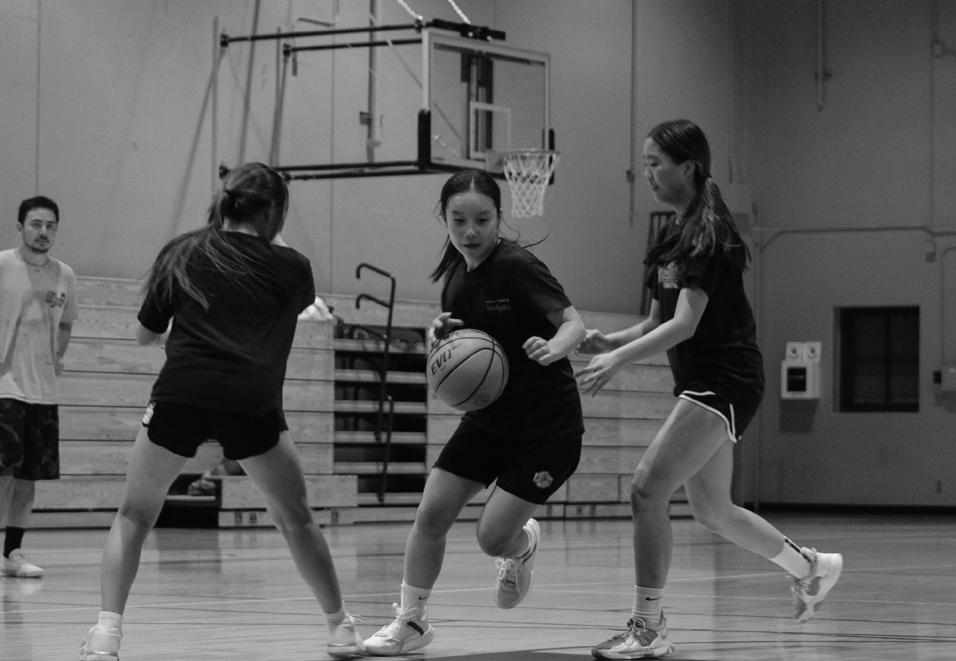
 STORY ROSE VANDEVELDE
PHOTO SHIN-HYE (RACHEL) CHOI
STORY ROSE VANDEVELDE
PHOTO SHIN-HYE (RACHEL) CHOI
Girl’s Basketball is shooting for a successful season ending in CIF victory. The team looks to build on the previous two year’s Rio Hondo League championships, and 9-1 league record last season.
Three key players from last year’s team have graduated, so basketball will turn to experienced returning seniors Peyton Washington and Lotis Shoun in their fourth year in the program. In addition to the seniors, the team will look to junior Dylan Tse to help drive the team’s offense after she averaged over 20 points per game last season. Junior shooting guard Olivia Alfonso will help bring the team together as a vocal leader and aggressive player on the court. Also a junior, Jamie Rain Kim will elevate the team’s play as a talented shooting guard and point guard.

“What I’m looking forward to the most is building a really strong team dynamic. We all laugh and have fun with each other, so I’m looking forward to seeing that same energy in our playing this year,” Washington said. “Each player has spent time in [the] gym and practiced as hard as possible to the best of their ability. I think we can reach the goals we made last year- league champions- as well as reaching CIF again.”
Long-time South Pasadena girls basketball Coach Cody Masden has high hopes for the season, ending in a CIF championship. Last year the team made a valiant effort to get to the third round of CIF, but stumbled in the quarterfinals. This year Coach Masden plans to take the team all the way, building on a foundation of positive team culture that goes with strong defense.
“[We put a] strong emphasis on a family type environment. They all look out for each other on and off the court and [are] able to talk about anything and talk about themselves to each other and build chemistry off the court to be successful team on the court,” Masden said. “We always want to be known as one of the toughest defensive teams and the team that’s never going to quit.”
Many of the returning players who largely make up the team already know that team culture, and their prior experience playing at the varsity level will be another key that the team will count on to be successful.
“We’re going to take all that experience that we went through last year playing tough teams and fighting through being banged and bruised up and then we’re going to try to apply it to this year and understand what it takes now to get to the next level and next round of CIF.” Masden said.
COMING OFF OF A DOMINANT PERFORMANCE IN LEAGUE PLAY LAST SEASON, the team is ready to make a deep CIF run.
Another factor that the team hopes will help them succeed is their versatility. With a balanced roster, basketball will have many different lineup options, allowing them to adjust to any team or situation.
“For our team, no matter which five we have out of everybody we have on our whole roster, everyone is a difference maker,” Masden said.
“This year our team is the definition of well rounded, we have a good amount of players for each position compared to last year. I can expect this will help before, during and after season. Right now we’re trying to get some flow into our games, and we’ve managed that with practice almost everyday and upcoming tournaments.” Washington elaborated.
The team prepared for the season with summer and fall basketball leagues as well as extra practices and weight room three times a week, which were all to help improve, and to build team chemistry.
“I’m most looking forward to winning games and getting to know my teammates better,” Shoun said. “I believe our team is more than ready for the season, and I have high expectations; I believe we will win the majority of our games.”
In addition to their overall goal of a CIF title, basketball hopes to keep last season’s momentum going and win the Rio Hondo League Title for the third year in a row.
The team is scheduled to play their first game on Friday, Jan. 6th against the Monrovia Wildcats at 5:15.
TIGER OCTOBER 20, 2022
After months of training and dedicaton, the South Pasadena High School Varsity Football team prepares to play at the largest venue of the season.
PAGE DESIGN ALLISON LEE 14 SPORTS
Zackary Quezada: walking on water on and off-campus
With a passion for hockey and water polo, Quezada has achieved athletic success at SPHS.
SPHS senior Zackary Quezada has earned his accomplishments. As captain of the varsity Boys’ Water Polo team, even with the competitive and fastpaced environment that surrounds water polo, he has managed to fit in another sport: hockey.
Playing two sports has cut into the time he can devote to each, yet has not stopped his drive and motivation to achieve success. Quezada plays water polo at SPHS in the fall, but he also plays hockey from September to April.
“Playing water polo definitely affects the amount of time I can dedicate to playing hockey,” Quezada said. “During the water polo season I have to miss a lot of practices and games [for hockey] because the schedules for the two sports overlap a lot, but once the water polo season is over I can go back to being committed to hockey.”
After being encouraged by his brother to play water polo in his freshman year, Quezada made the junior varsity team at SPHS with no prior experience. He had been watching his brother play since a young age and has loved the sport ever since.
“I liked water polo since I was really young and I feel like it’s my sport and it [has] always felt like it’s my sport.” Quezada said, “[With] water polo, I really feel a connection to both the team and the players and the program.”
Quezada leads the varsity water polo team as a dual-sport athlete. He began playing hockey when he was ten years old, and currently plays club hockey at Ontario Junior Reign, Triple A. Quezada also plays hockey for St. John Bosco High School, even though he attends SPHS.
“Playing for St. John Bosco hockey is kind of like playing for another club team. The practices are closer to the school, we wear their jerseys, and a lot of the players on my team actually go to the school but for me it’s pretty normal,” Quezada said. “I play for St. John Bosco because I really like playing hockey and there is no [SPHS] hockey team so it doesn’t bother
UPCOMING GAMES
STORY CLEMENTINE EVANS
me too much to play for another school but I would like it a lot better if SPHS had its own team.”
Quezada hopes to guide the players of the Water Polo team and give them a season to remember.
As an experienced player, he has had several role models that allowed him to become the best athlete he could be.
“I was always very fortunate to look up to other role models when I was on the team last year. Like [graduated senior] Caleb Hunt who was the captain…last year. I’ll always look up to him, I mean, he showed me the ropes and, so I really try to emulate that to the younger players and try to do that. So there are a lot of moments where you think, ‘Are my actions helping the people younger than me, am I being a role model to the people younger than me?’... I always try to be responsible, but lately I’ve been trying to be extra responsible this year.”
He brings this same mindset into academics. Quezada is looking towards USC for his future. Instead of using his PSAT, he submitted his SAT scores. To his surprise, this decision earned him a spot in the National Merit Scholar Semi-Finals.
“This is not one of the things that I have worked for, but this one was just given to me, but I [am] very excited to have. It [is] a great opportunity at a scholarship, especially because the college I [am] thinking of most is USC and they give at least a half scholarship if I [am] a finalist, so it [is] really good,” he added.
Quezada’s many achievements have helped him lead his team. Representing both South Pasadena High School and St. John Bosco High School allows him to improve his athletic game.
While water polo has stretched Quezada out thin, he continues to pursue his passion of hockey for eight years. Despite being thrusted into water polo suddenly, he appreciates the values it has taught him and the connections he has made from the sport. Being captain has educated him in the merit of teaching others to do better and to be the best player and athlete possible.

TUESDAY, OCT. 25TH @ 4:00 PM, BOYS WATER POLO VS. MONROVIA AT HOME
THURSDAY, OCT. 27TH @ 5:30 PM, BOYS WATER POLO VS. LA CAÑADA AT LA CAÑADA
FRIDAY, OCT. 28TH @ 7:00 PM, FOOTBALL VS. SAN MARINO AT SAN MARINO
SPHS hires new soccer coach Jeremy Gonzalez
STORY ETHAN KWAK PHOTO EMIKO (EMI) ESSMILLER
SPHS Girls Varsity Soccer ended the 2021-2022 season placing second in the Rio Hondo League, with a solid 6-44 overall record and 5-1-3 mark in league. However, Coach Danielle Jones, who led the team to a successful 57 percent win rate, is not returning this year. She will continue her career as a year round coach at Cal State in Dominguez Hills.
The team will instead begin practices in the first week of November under the leadership of new head coach and SPHS alumni Jeremy Gonzalez. As an SPHS graduate and former player on the varsity soccer and basketball teams, Gonzalez looks forward to supporting the growth of the SPHS athletic program.
“Growing up in South Pasadena, I was provided with many opportunities from our community which I have always been grateful for. Through soccer, I now have the opportunity to give back to the community by supporting our student athletes both on and off the field,” Gonzalez said. “Any way I can to support the SPHS Athletic Program, I’m in.”
Gonzalez hopes to continue the trend of victory with his extensive background and experience in coaching, especially through local South Pas teams.
“For the last ten years I’ve been coaching youth soccer locally, and most recently, I have had the privilege of running our local South Pasadena AYSO EXTRA Program. I have been coordinating multiple teams and coaches to develop student athletes to be as competitive as possible,” Gonzalez said.

On top of his coaching experience, Gonzalez had an extensive playing career on the pitch and played at the highest level Youth Club Soccer Circuit for 10 years.
“I was fortunate to have been trained by college, professional and National Team coaches. After High School, I continued my soccer career, playing four years in college,” Gonzales said. His main ambition for this season is to compete and win a California Interscholastic Federation (CIF) title, the ultimate athletic achievement for any high school team. CIF is the playoffs for California sports teams and it is divided into competitive sections. To win this is a coveted accomplishment; a milestone that Gonzalez feels is within reach.
“Winning CIF is always a goal of ours,” Gonzalez said. “We have a long history of achievements and accomplishments, and I’m grateful for the opportunity to help lead our program to continued success.”
A main factor in Gonzalez’s hiring was his attitude and connections to the sports culture at SPHS. Gonzalez exceeded the criteria due to his lifelong dedication to coaching and improving young athletes through his network of local coaches and the AYSO EXTRA.
“Out of all our applicants, [Jeremy Gonzalez] stood out as someone who would be committed to the program, our student-athletes, and serving the community,” SPHS Athletics Director Anthony Chan stated via email correspondence. “He has high energy and passion, and is willing to put forth the time and effort to work with our program. His coaching strategy, coupled with his use of our analytic systems in Hudl and film breakdown to get our student-athletes playing at the next level was another reason he rose to the top. I am excited for what Coach Gonzalez will bring to our Girls Soccer Program.”
The Tigers will open the regular season against the Monrovia Wildcats on Jan. 6, 2023.
WITH PRACTICES BEGINNING IN EARLY NOVEMBER, SPHS soccer coach Jeremy Gonzalez hopes to kick off the season on the right foot.
TIGER OCTOBER 20, 2022
PHOTO SAMANTHA SHIROISHI
FROM HOURS ON THE ICE AND IN THE POOL, Senior Zackary Quezada makes waves both academically and athletically at SPHS.
PAGE DESIGN ALLISON LEE 15SPORTS
Volleyball roars past Monrovia on Senior Night

Who Stole My Goggles?
ALLISON LEE
Saying good-bye to “Simon Says”
For as long as I can remember, I have always felt trapped in the world’s largest game of Simon Says. In a simple, childish game composed of a leader and a follower, I am often destined to portray the role of the follower, where I am constantly bound for elimination.
If “Simon” tells you to complete an action, you are not supposed to question or second guess what “Simon” asks. Similar to being raised as an athlete, you are constantly engraved with the mentality that coaches are always correct, searching for approval. But sometimes, knowing when you should say “no” to your coaches or parents can become a difficult task.
Attending sports practices was the highlight of my days towards the beginning of my freshman year. Following hours of intensive work in the classroom and following a rigorous extra-curricular schedule, diving into the pool to practice shots, or going through drills in the pitching bullpen allowed me to express my emotions and pent-up thoughts freely.
No matter what adverse events happened that day, these facilities began to feel like safe havens for me, in which my troubles with the outside world no longer concerned me.
Transitioning from a winter-season to a springseason sport as a dual-sport athlete was difficult.
As the rest of my teammates already had months of conditioning and practice in specific positions, I constantly felt behind with a hungry desire to prove myself continuously.
The softball coaching staff pulled me aside to converse in private after my first week of tryouts.
STORY LINDA YUN PHOTO SHIN-HYE (RACHEL) CHOI
Girls volleyball concluded the season with a record of 8-2, finishing second in the RHL. After sweeping the Monrovia Wildcats on Tuesday, Oct. 11, the team is hopeful for a CIF title. The annual Senior Day match was decided in three sets, with scores of 25-7, 25-17, and 29-27, respectively.
South Pas honored the Monrivia seniors with bouquets of dandelions. Senior captain Ava Dorny was walked down by sisters Senya and Grace Dorny and commemorated with flowers and assorted goodies. Coach Ivy Chew and assistant coach Trevor Lanzarotta were honored for their efforts in the program.
Before the match began, the teams gathered around the screen to watch a compilation of the Tigers’ best plays. The team of 14 ran through tunnels formed by their younger JV and Frosh Soph teammates.
Junior setter Kendall Taylor hit the first serve on the Tigers’ home court. In a turn of events, the Wildcats managed to take the reins of the rally. With a powerful spike, the ball cut through the Tiger defense and put the Wildcats ahead 1-0. The Wildcats’ momentum continued for three more rallies until middle hitter Ava Dorny served an ace. Dorny continued to sail three more consecutive aces in the first set, putting the Tigers in the lead 8-4.
Taylor’s awareness provided South Pas with a reliable offense. Junior outside hitters Helena Foord and Jenna Garner, and junior opposite hitter Ingrid Zahn frustrated the Wildcats with consistent blocks and unpredictable hits to bring home the first set 25-7.
The Wildcats were determined to put up a fight. An ace captured the first point of the second set as the Wildcats swerved into an offensive formation. Instead of letting their opponents slide, the Tigers paid them back on their own coin. Garner captured two points with back-to-back aces, while junior libero Mia Ramos made crucial digs to Taylor who set the tone for each rally.
With the scoreboard favoring the Tigers of 14-6, the Wildcats needed a comeback, and fast. Their quality of coverage improved dramatically, and the gap began to narrow. While the Wildcats tried to shake off the slow start, the Tigers were looking ahead. At 20-13, the opponents called time-out.
As the teams inched closer to game point, South Pas remained in the lead. Each point from the guests was met with another from the home-team. In the end, Monrovia’s long-winded recovery was fruitless. A final ace from Foord concluded the second set 25-17.
Before long, SPHS pep populated the home crowd. With the help of the lively cheer squad, sophomore setter Jolene Wu scored the first point for the Tigers. Dorny and Garner deflected an array of spikes from the Wildcats to put the Tigers ahead 10-6.
High on the landslides from the first two sets, the Tigers began to swap out their starting lineup. Poor communication allowed the Wildcats to noticeably increase the accuracy of their attacks. A solid dig from junior defensive specialist Tabitha Lee Chon dropped to the ground as two teammates watched, both expecting the other to hit it. For the first time, the Wildcats took a 22-21 lead. Still, the game remained too close to call.
The teams fought for possession until the last rally. A spike from the Wildcats landed out of bounds, lending the Tigers a one-point lead. Just when the pendulum seemed to have swung in the Tigers’ favor, the Wildcats won back another rally. Dorny awarded the Tigers a tip, putting the pressure of the closing serve on Taylor.
Taylor delivered an unpredictable float, which returned safely for Foord to strike the last blow. With a powerful hit from Foord, the Tigers clocked a 29-27 victory in the third and last set.
Girls volleyball looks forward to a successful CIF run. The team hopes to triumph over the Cajon Cowboys from the Citrus Belt in the first round of playoffs on Thursday, Oct. 18.
For a moment that seemed like it would never end, each coach took turns ridiculing insults in front of me, away from my teammates. From insulting my ethnicity, athletic build, to even hurling false accusations about who I was as an individual, these three adults had found every way to rebuke the insecurities of a fifteen-year-old girl.

The place and team I used to consider my family no longer felt like a safe environment. The soft marmalade dirt that once provided a comforting texture under my metal cleats now felt dry and mundane. The locker room walls that were once filled with laughter felt obscure, trapping my negative thoughts and emotions. Most importantly, those I considered mentors and older sisters became aggrieved by my pleas for help.
I sought the advice of our campus’ administration, friends, and parents but despite my best efforts to seek help, everyone had turned their cheek in the other direction. The freshman who is “crazy and desperate” for playing time in a varsity-level position was against the world.
Though my personal experience may not have been as extreme as those of other athletes, there remain numerous coaches from local to professional levels that get away with negative, bully-like behavior. As we have been conditioned to believe the instruction of coaches is impactful positively, to what extent is it worth invalidating the experiences and emotions of athletes who experience these situations first-hand?
As time has progressed and I have grown from these experiences, the resulting torment has led to a life of grief and pain. Unlearning these harmful practices has caused many breakdowns and the slow process of learning to have a different outlook on my athletic experience here at SPHS. Rather than playing to survive, I now choose to play for enjoyment and to develop stronger skills. So “Simon,” if you are still out there, it is time to pick a new game to play.
@SPHSTigerNewspaper
AS GIRLS VOLLEYBALL EYES THE FIRST ROUND OF CIF , the team honored senior Ava Dorny in their last high school season.
BUT WAIT! INSTAGRAM @tigernewspaper TWITTER @SPHStiger FACEBOOK tiger.newspaper There’s more... CHECK OUT MORE COVERAGE ON ONLINE tigernewspaper.com YOUTUBE
TIGER OCTOBER 20, 2022
PAGE DESIGN ALLISON LEE & ELLA MIZOTA-WANG 16 SPORTS






















 MICHAEL MAYEMURA
MICHAEL MAYEMURA











 STORY CLEMENTINE EVANS ILLUSTRATION ISOLE KIM
STORY CLEMENTINE EVANS ILLUSTRATION ISOLE KIM


 STORY MORGAN SUN, JAYDEN TRAN, & ROSE VANDERVELDE
STORY MORGAN SUN, JAYDEN TRAN, & ROSE VANDERVELDE






 STORY ROSE VANDEVELDE
PHOTO SHIN-HYE (RACHEL) CHOI
STORY ROSE VANDEVELDE
PHOTO SHIN-HYE (RACHEL) CHOI




